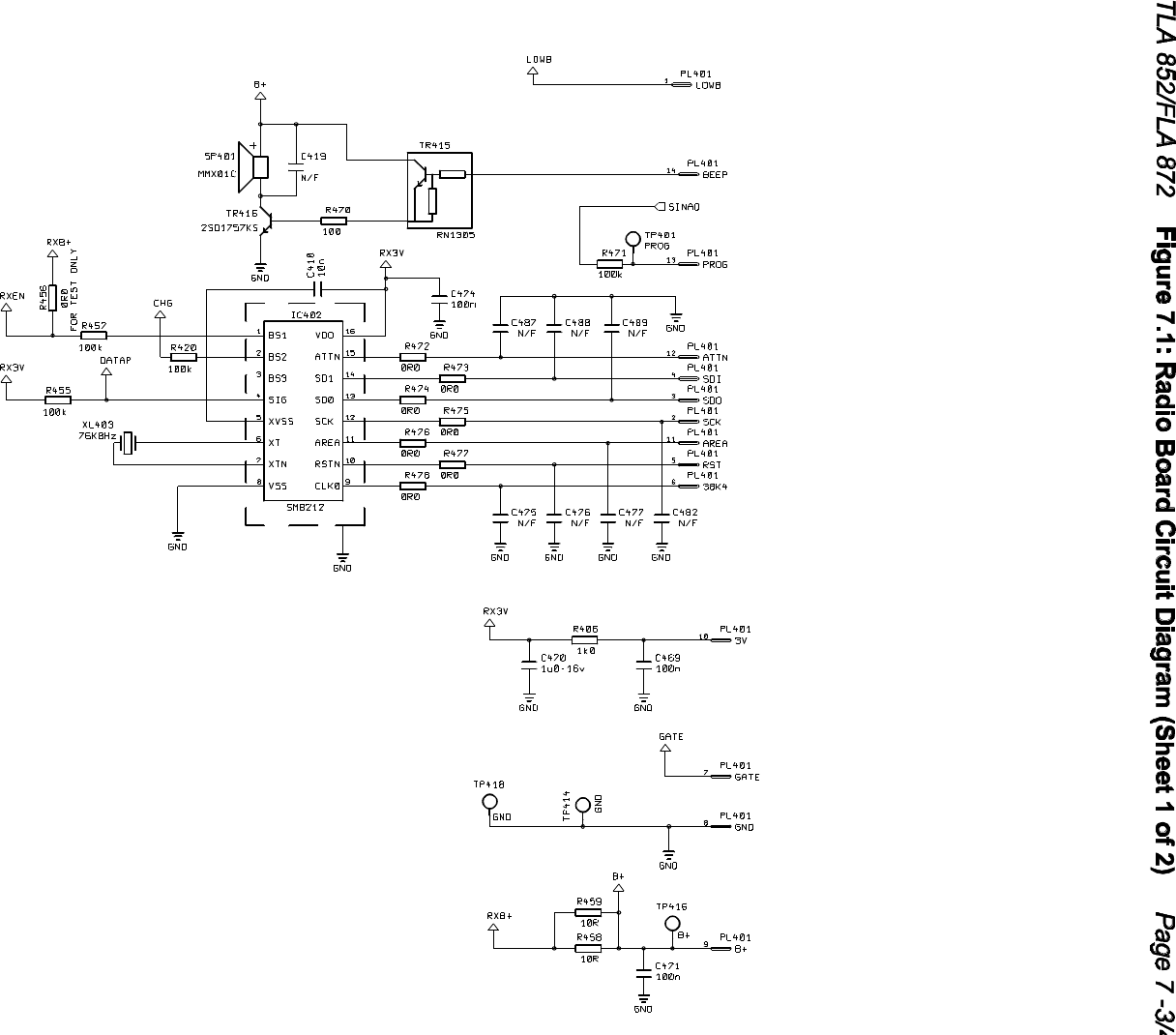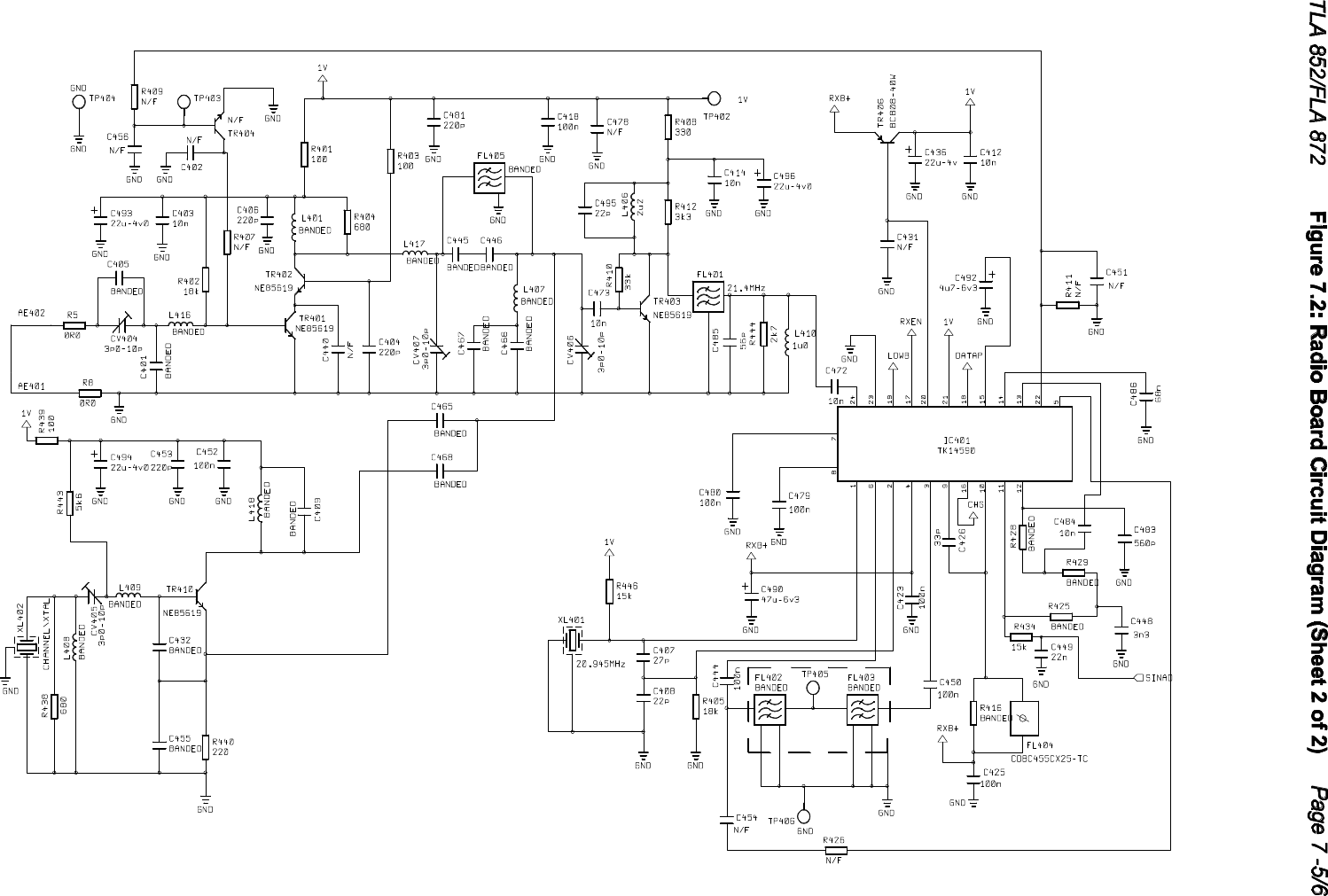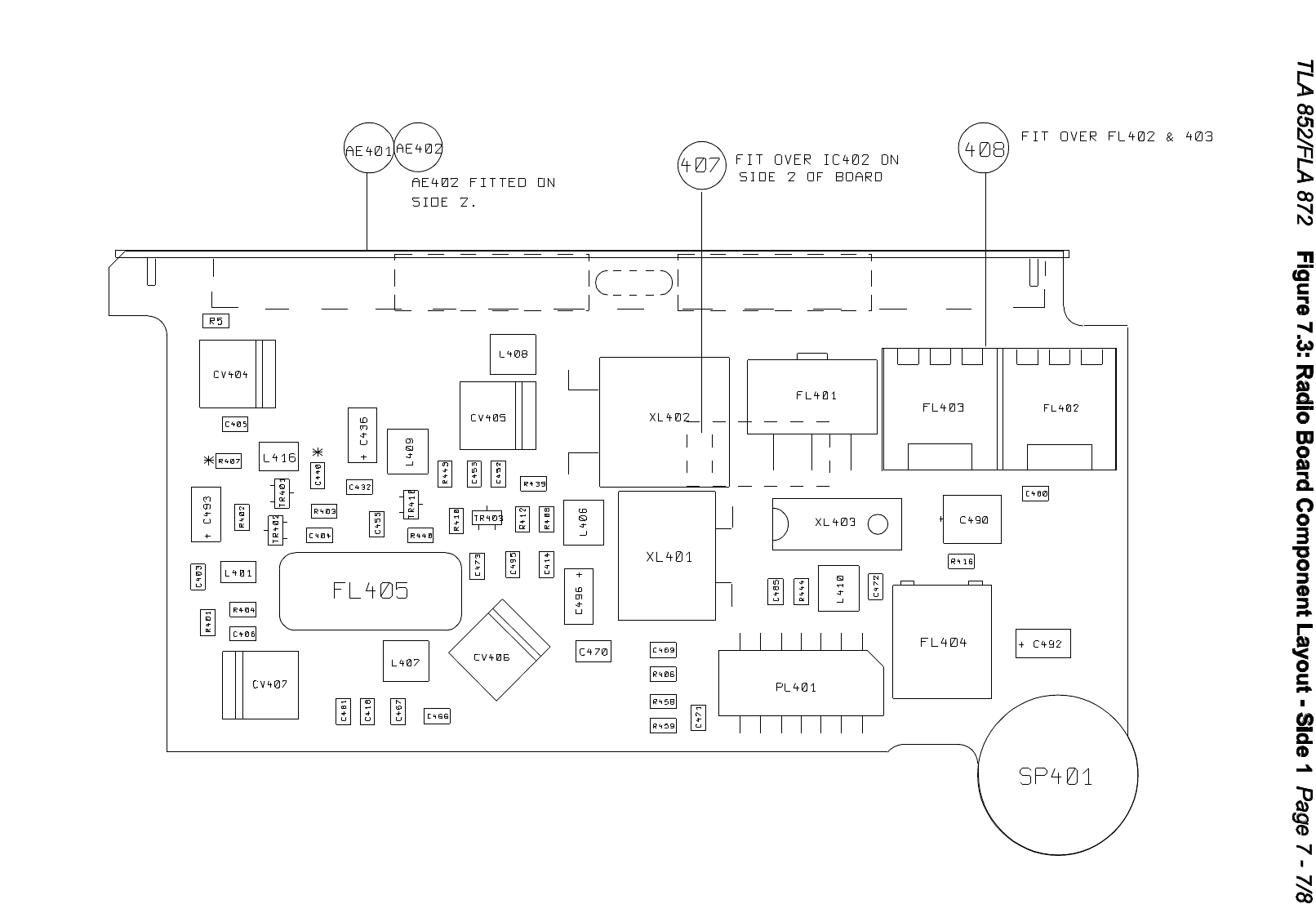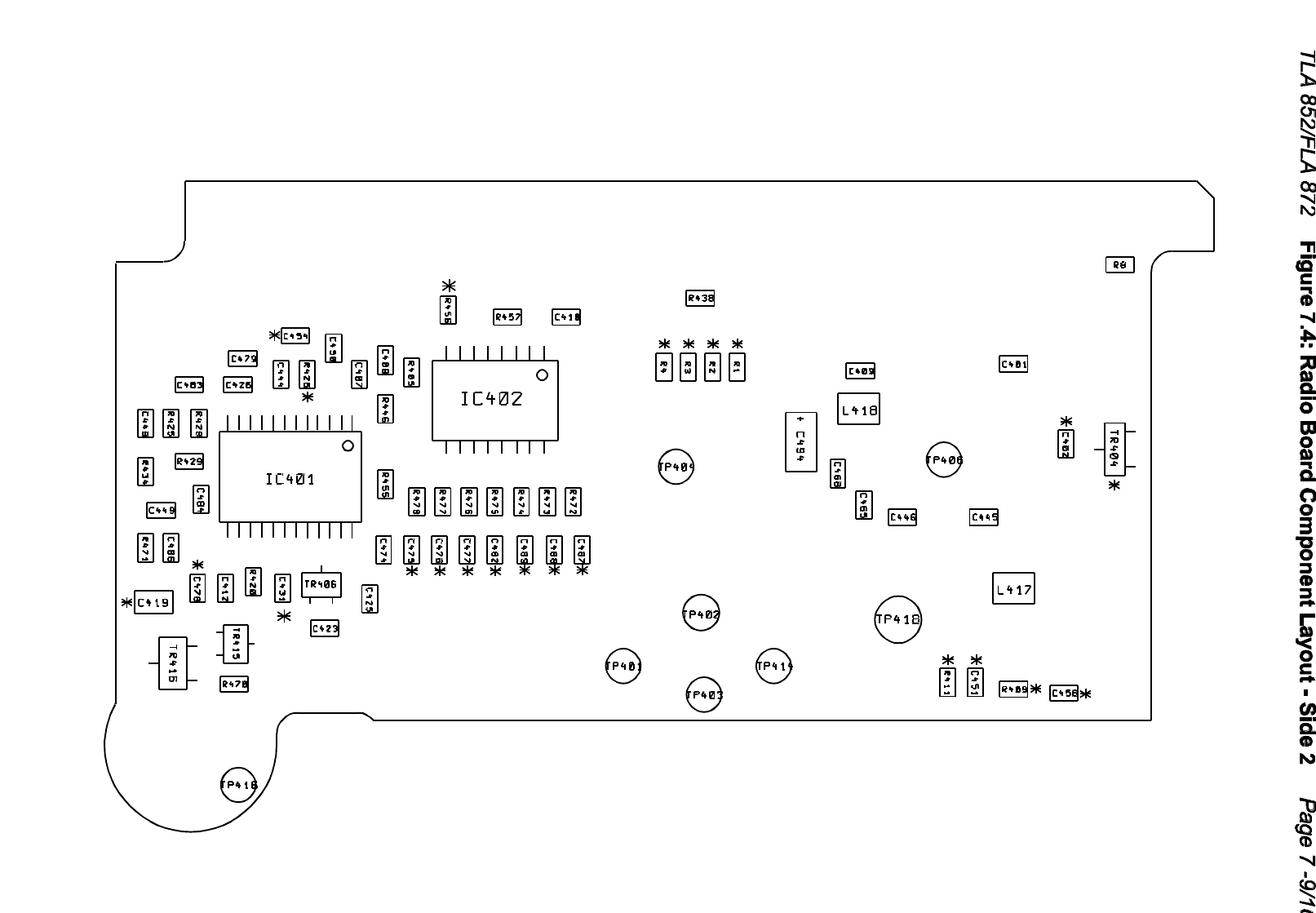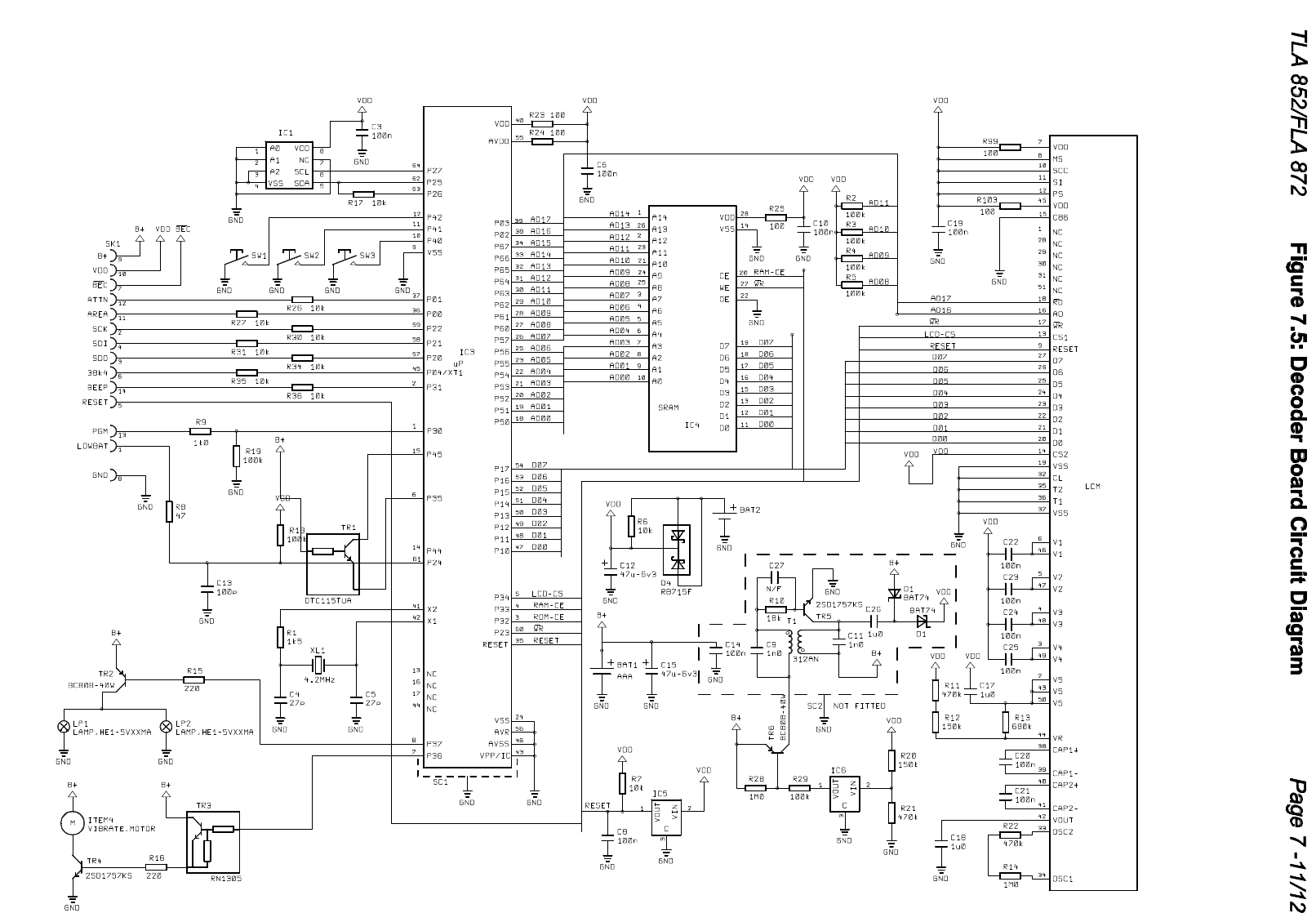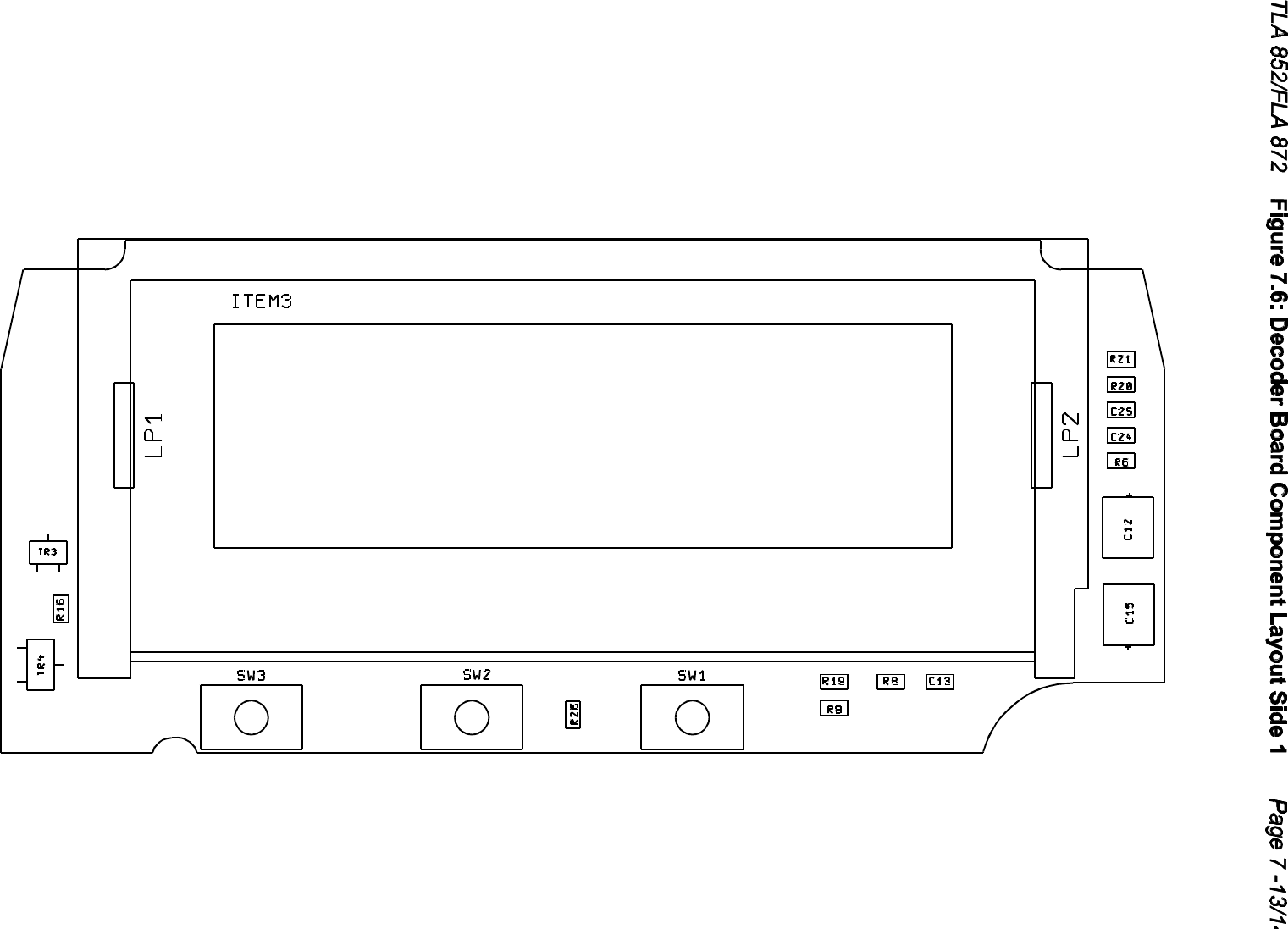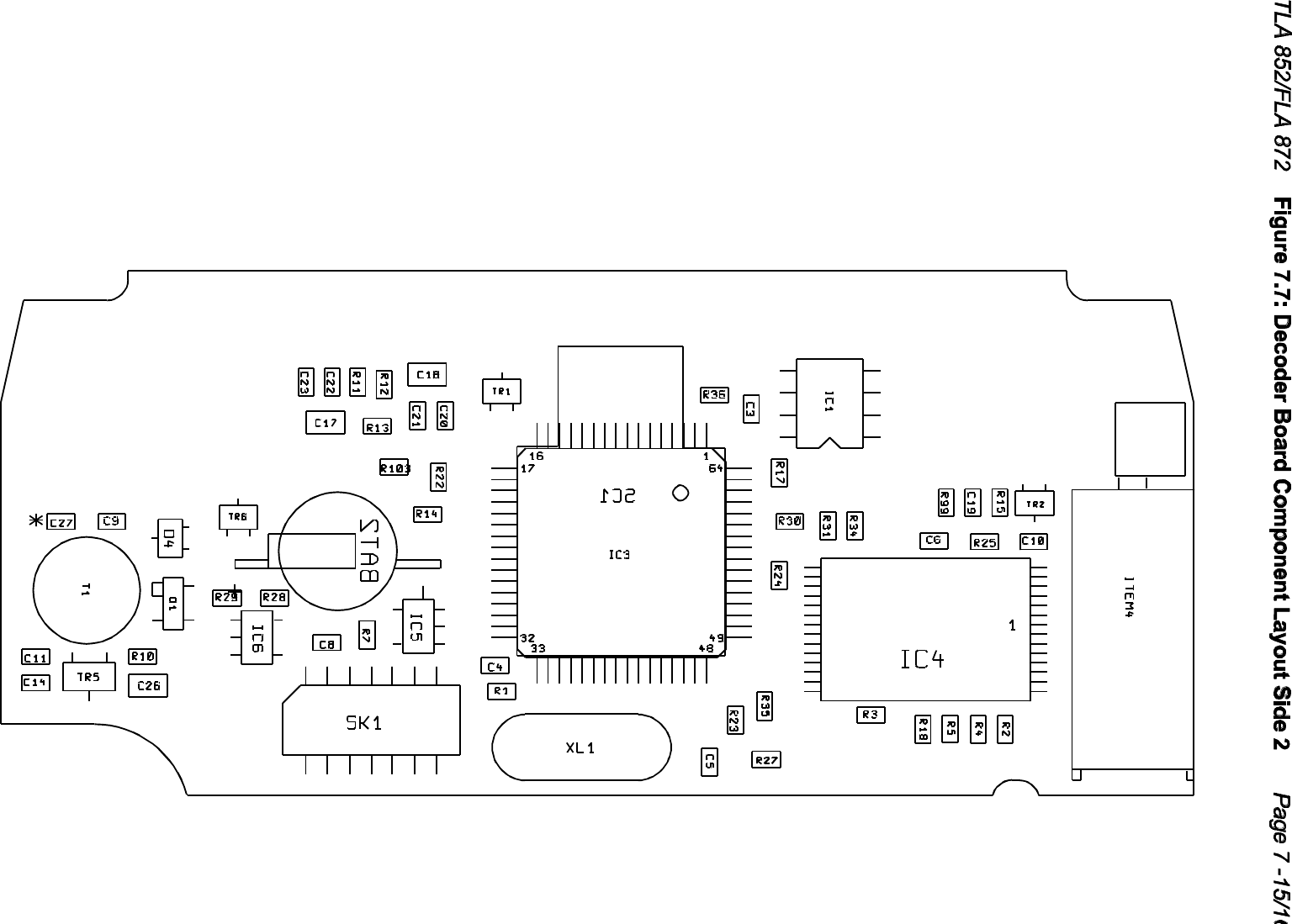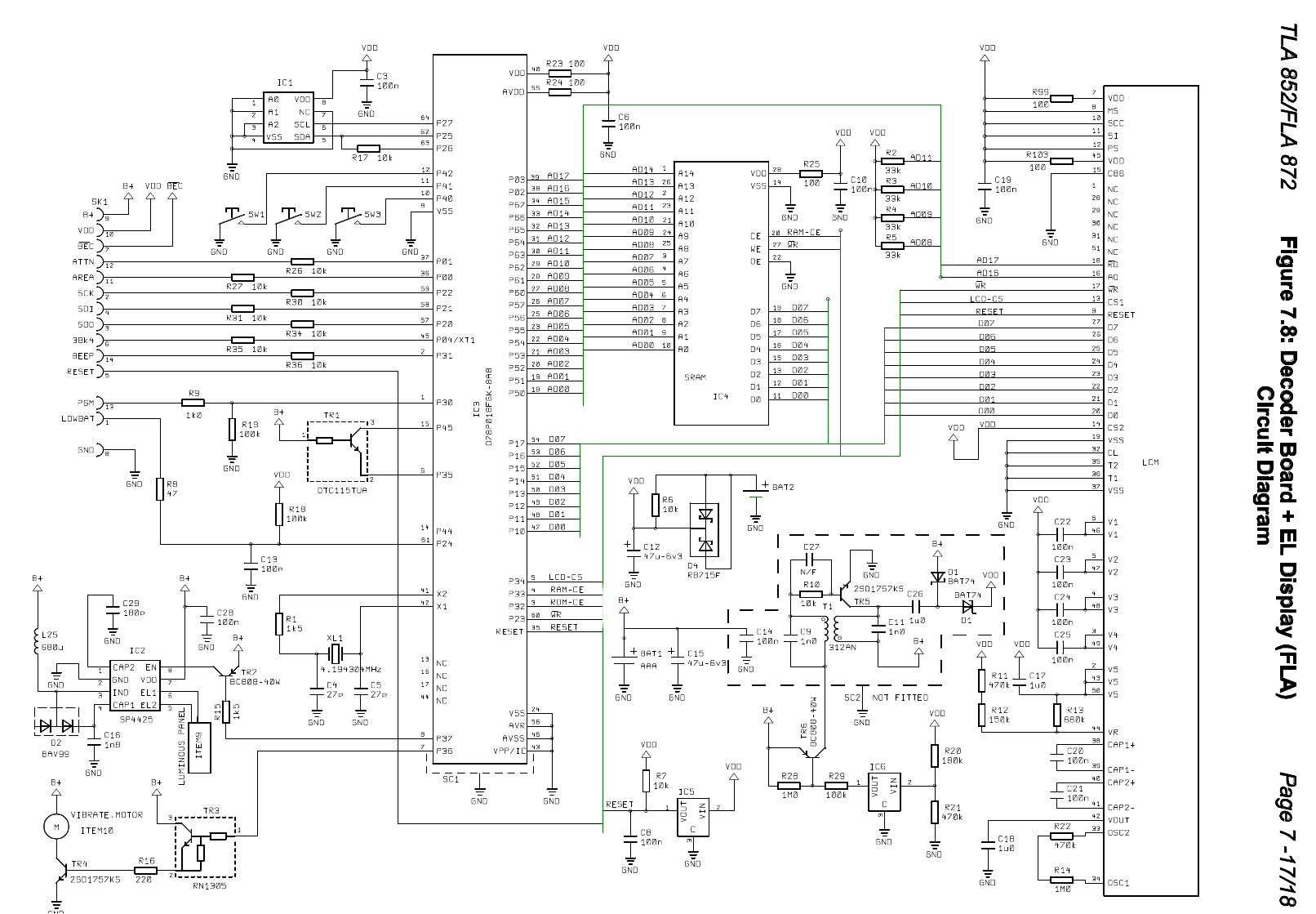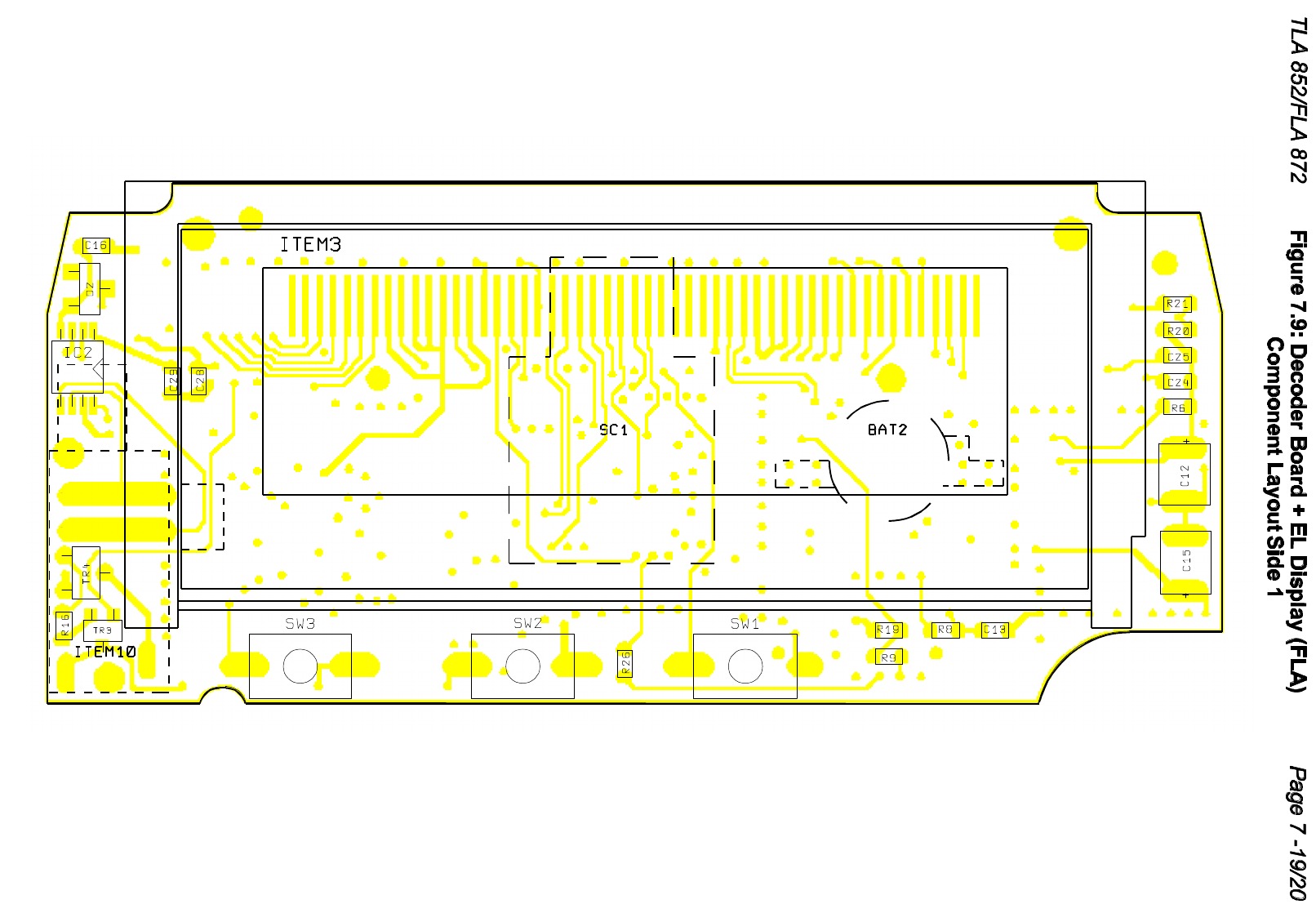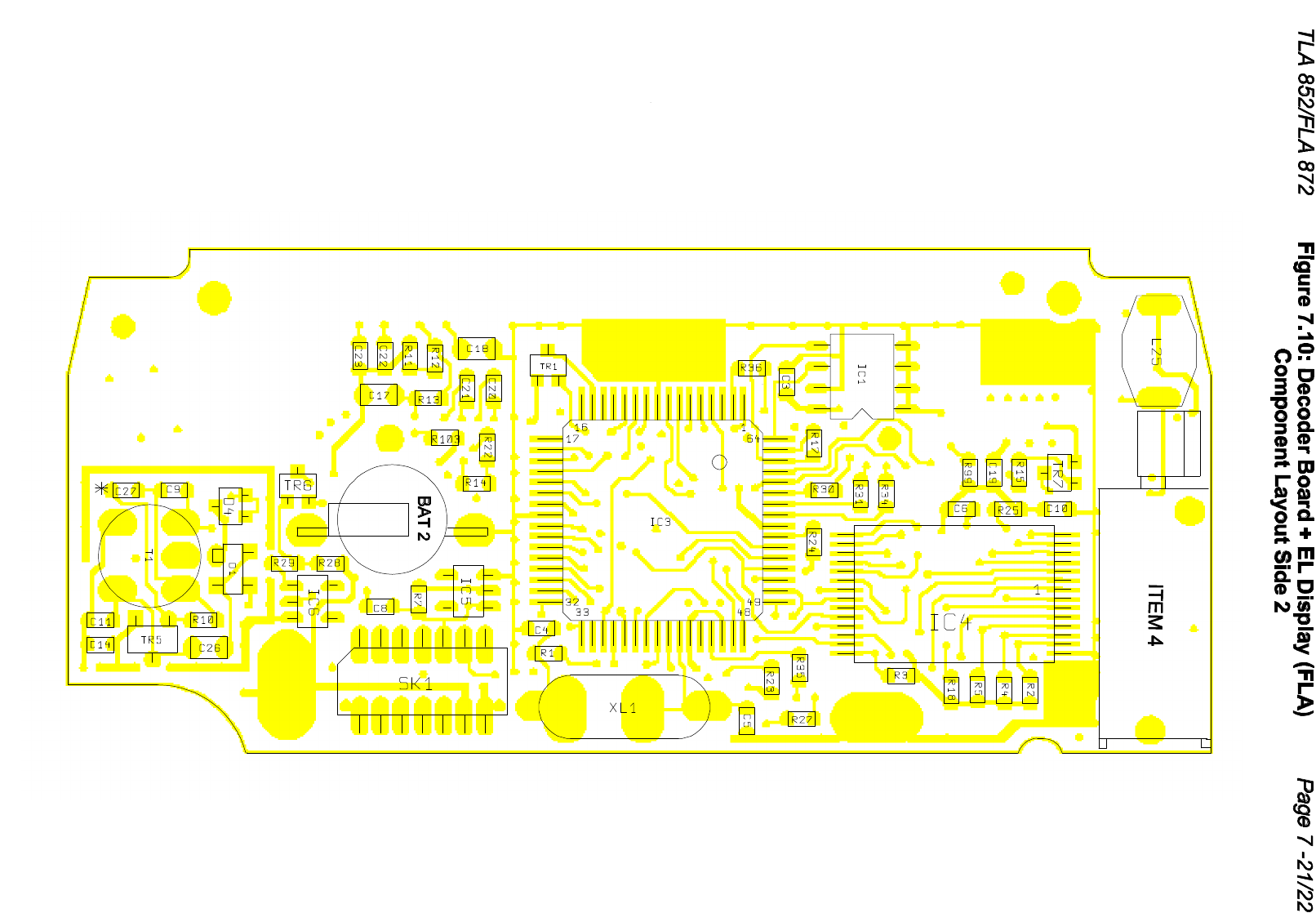Multitone Electronics PLC TLA-FLA Alphanumeric VHF Radio Paging Receiver User Manual TM1205pr
Multitone Electronics PLC Alphanumeric VHF Radio Paging Receiver TM1205pr
Contents
- 1. Technical Manual
- 2. Users Guide
Technical Manual

>
TM1205 Issue 1 Page (i)
TECHNICAL MANUAL
for
RADIO PAGING RECEIVERS
MODEL TLA 852
and
MODEL FLA 872
Printed and Published in England

TLA 852/FLA 872
TM1205 Issue 2Page (ii)
COMPANY LIABILITY
The information in this manual has been carefully compiled and checked for technical
accuracy. Multitone Electronics plc accept no liability for inaccuracies or errors. In line with
the company policy of technical advancement, the information within this document may be
changed. The user should ensure that the correct issue of the document is used. Comments
or correspondence regarding this manual should be addressed to:
Multitone Electronics plc
Multitone House
Beggarwood Lane
Kempshott Hill
Basingstoke
Hampshire RG23 7LL
England
ISSUE DATE
2 November 2002
© 2002 Multitone Electronics plc
TM1205 Issue 2 Page (iii)
CONTENTS
Page (i) Title Page
Page (ii) Company Liability
Page (iii) Contents
Page (iv) Effective Page List
Page (v) Safety Summary
Warning
Page (vi) Caution
Section 1 Introduction and Specification
Section 2 Operating Instructions
Section 3 Technical Description
Section 4 Installation & Commissioning
Section 5 Servicing
Section 6 Spare Parts List
Section 7 Diagrams
TLA 852/FLA 872
TM1205 Issue 2Page (iv)
EFFECTIVE PAGE LIST
Page No. Issue Page No. Issue Page No. Issue
(i) 12-9 15-3 1
(ii) 12-10 15-4 1
(iii) 12-11 15-5 1
(iv) 12-12 15-6 1
(v) 12-13 15-7 1
(vi) 12-14 15-8 1
1-1 12-15 15-9 1
1-2 12-16 15-10 1
1-3 13-1 15-11 1
1-4 13-2 15-12 1
1-5 13-3 15-13 1
1-6 13-4 15-14 1
2-1 13-5 15-15 1
2-2 13-6 15-16 1
2-3 13-7 15-17 1
2-4 13-8 15-18 1
2-5 13-9 15-19 1
2-6 13-10 15-20 1
2-7 14-1 1
2-8 14-2 1
5-1 1
5-2 1
5-21 1
5-22 1
5-23 1
5-24 1
Page No. Issue
5-25 1
5-26 1
6-1 1
6-2 1
6-3 1
6-4 1
6-5 1
6-6 1
6-7 1
6-8 1
7-1 1
7-2 1
7-3/4 1
7-5/6 1
7-7/8 1
7-9/10 1
7-11/12 1
7-13/14 1
7-15/16 1
7-17/18 1
7-19/20 1
7-21/22 1

TM1205 Issue 1 Page (v)
THE RECEIVER SHOULD NOT BE CARRIED INTO AREAS WHERE EXPLOSIVE
GASES, OR DUST MAY BE PRESENT.
FCC & IC Statement Of Compliance
This device complies with FCC Part 15 & Industry Canada RSS210 regulations. Operation is
subject to the following two conditions:- (1) this device may not cause harmful interference and
(2) this device must accept any interference received, including interference that may cause
undesired operation.
Unauthorised modification to this equipment, will void the user’s authority to operate the device
under the terms of the above regulations.
SAFETY SUMMARY
The following information applies to both operating and servicing personnel. General Warnings
and Cautions will be found throughout the manual, where they apply, which refer to the applicable
part of this summary.
WARNING statements identify conditions or practices that could result in personal injury or loss
of life.
CAUTION statements identify conditions or practices that could result in equipment damage.
WARNING
CAUTION
STATIC SENSITIVE DEVICES ARE USED WITHIN THIS EQUIPMENT. CARE MUST BE
USED TO ENSURE DAMAGE TO THESE DEVICES IS NOT CAUSED BY HIGH LEVELS OF
STATIC ELECTRICITY. SPARE BOARDS OR COMPONENTS SHOULD BE STORED IN
ANTI-STATIC PACKAGING WHEN NOT INSTALLED IN THE EQUIPMENT.
PROTECT THE RECEIVER FROM LIQUIDS, STRONG MAGNETIC FIELDS AND EXTREME
TEMPERATURES. DO NOT LEAVE THE RECEIVER EXPOSED TO STRONG SUNLIGHT.
AREAS SUCH AS WINDOW LEDGES ARE TO BE AVOIDED.
TLA 852/FLA 872
TM1205 Issue 2Page (vi)
INTENTIONALLY BLANK
TLA 852/FLA 872
TM1205 Issue 2 Page 1 - 1
SECTION 1
INTRODUCTION & SPECIFICATION
CONTENTS: Page
1.1 INTRODUCTION 1 - 2
1.2 FEATURES 1 - 3
1.3 SPECIFICATIONS 1 - 3
1.3.1 Receiver Performance 1 - 3
1.3.2 Power Supply 1 - 4
1.3.3 Code Format 1 - 4
1.3.4 Memory 1 - 5
1.3.5 Displays, Controls and Alerts 1 - 5
1.3.6 Operational Environment 1 - 6
1.3.7 Physical Characteristics 1 - 6
TABLES:
1.1 Sensitivity Figures 1 - 4
TLA 852/FLA 872
TM1205 Issue 2Page 1 - 2
1.1 INTRODUCTION
The MultitoneTLA 852 and FLA 872 Radio Paging Receivers are VHF receivers
which receive messages sent in CCIR Radiopaging Code No.1 (RPC1).
The front panel of the unit has a Liquid Crystal Display (LCD) to display messages
and other information. The three buttons on the front panel are used to control the
functions of the unit.
The LCD of the TLA 852 can show a maximum of two lines of 20 alphanumeric
characters; the FLA 872 has the option of showing a maximum of four lines of 20
characters, or two lines of double height characters. The displays can also show a
maximum of seven symbols in a line.
If the TLA 852 receives a message that is longer than 40 characters, it displays the
first 40 and stores the excess. The front panel buttons are used to transfer the
stored part of the message to the screen as required. Similarly, if the FLA 872
receives a message which has more than 80 characters (40 characters in double
height mode) the excess characters are stored.
Message alert is provided by an audible beep tone or by the unit vibrating. The
buttons are used to select the preferred alert.
Power for the unit is supplied by a single AAA battery. A door on the rear of the unit
gives access to the battery.
A back-up supply for the unit is available when the battery is changed. The back-up
supply is provided by a large-value capacitor mounted on the decoder board in the
unit. The capacitor, when fully charged, can maintain data in the unit for more than
5 minutes.
The unit case is a two-piece plastic moulding secured by two cross-head screws. A
lanyard is supplied with the unit which can be fastened to the case and the attached
clip used to secure the unit to a suitable object.
TLA 852/FLA 872
TM1205 Issue 2 Page 1 - 3
1.2 FEATURES
The unit has these features:
!Displays two lines of 20 characters - TLA 852 (four lines - FLA 872)
!Message Store
!Information Service Messages (Optional)
!Display Backlight
!Date/Time Display
!Selectable Alert - Audible Beep or Vibration
!Alarm
!Out of Range Indication (Optional)
!Timed-off Mode
!Low Battery Warning
!Battery Economy
1.3 SPECIFICATIONS
1.3.1 Receiver Performance
Frequency Range: 138MHz through 174.1MHz
Frequency Bands: Band 1: 138.000MHz - 143.499MHz
Band 2: 143.500MHz - 148.999MHz
Band 3: 149.000MHz - 154.999MHz
Band 4: 155.000MHz - 160.999MHz
Band 5: 161.000MHz - 167.499MHz
Band 6: 167.500MHz - 174.100MHz
Channel Spacing: 10/12.5/25kHz
Intermediate Frequencies: 21.4MHz and 455kHz
Crystal Frequencies:
Local Oscillator: Carrier Frequency minus 21.4MHz
2nd Oscillator: 20.945MHz

TLA 852/FLA 872
TM1205 Issue 2Page 1 - 4
Sensitivity:
The sensitivity figures quoted in Table 1 assume an ambient temperature in the
range 18EC through 25EC. The battery voltage should be above the low battery
trigger point of approximately 1.15 volts. At temperatures between the ambient and
maximum / minimum, performance is at an intermediate value. At temperature
extremes degradation of sensitivity shall not exceed 6dB.
Table 1.1: Sensitivity Figures
MEASUREMENT
MODE
BEST TEM CELL
POSITION, (dBm),
TYPICAL TYPICAL
BAUD
RATE
On Pole 14dBµVm -104dBm 1200
12dBµVm -106dBm 512
-1
-1
20dBµVm -101dBm 2400
-1
NOTE: The following performance figures are typical for an ambient temperature
range of 15EC through 35EC.
Adjacent Channel Selectivity: >78dB
Image Response: >70dB
Spurious Response: >70dB
Intermodulation Response: >62dB
Co-channel Rejection: >-6dB
1.3.2 Power Supply
Battery Type: Alkaline AAA (1.5 Volts Nominal)
Typical Battery Life: 800hrs
1.3.3 Code Format
The Code Type is CCIR Radio Paging Code No.1 POCSAG
TLA 852/FLA 872
TM1205 Issue 2 Page 1 - 5
1.3.4 Memory
Capacity: The units can accept messages to a
maximum of 1024 characters. They
can store a maximum of 32 read or
unread messages and six archive
messages.
Recall: Stored messages can be retrieved in
any order.
1.3.5 Displays, Controls and Alerts
Liquid Crystal Display: TLA 852: Two lines of text.
FLA 872: Four lines of text.
Control Buttons: Three push-buttons (Select, Left and
Right) on the front panel of the unit,
control all the functions of the pager.
Display Illumination: The display illumination is selected
ON or OFF from the Display Options
Screen, by using the front panel
control buttons.
Audible Alert: Various tone patterns can be selected
or muted from the Alert Options
Screen, by using the front panel
control buttons.
Vibration: The vibration alert can be set to ON
or OFF by using the front panel
controls.
TLA 852/FLA 872
TM1205 Issue 2Page 1 - 6
1.3.6 Operational Environment
The unit will operate to specification within these limits:
Operating Temperature: -10EC through +55EC
Storage Temperature: -20EC through +60EC
NOTE: There may be some degradation of display performance below 0EC.
1.3.7 Physical Characteristics
Dimensions: Width: 75mm
Height: 48mm
Depth: 17mm
Weight: 60g (with battery)
TLA 852/FLA 872
TM1205 Issue 2 Page 2 - 1
SECTION 2
OPERATING INSTRUCTIONS
CONTENTS: Page
2.1 CONTROLS AND INDICATORS 2 - 3
2.1.1 Display 2 - 4
2.1.2 Controls 2 - 4
2.2 OPERATING INSTRUCTIONS 2 - 4
2.2.1 General 2 - 4
2.2.2 Switching the Unit ON 2 - 4
2.2.3 Setting the Options 2 - 5
2.2.4 Archive 2 - 6
2.2.5 Alarm 2 - 6
2.2.6 Alert 2 - 7
2.2.7 Display Backlight (TLA 852) 2 - 8
2.2.8 Display Options (FLA 872) 2 - 8
2.2.9 Changing the Height of the Characters 2 - 8
2.2.10 Display Backlight (FLA 872) 2 - 9
2.2.11 Setting the Time and Date and Timed-off Time 2 - 9
2.2.12 Deleting Messages 2 - 11
2.2.13 Switching the Unit OFF 2 - 12
2.3 RECEIVING AND STORING MESSAGES 2 - 13
2.3.1 Receiving a Message 2 - 13
2.3.2 Reviewing Stored Messages 2 - 13
2.3.3 Archiving Messages 2 - 14
2.3.4 Reviewing Information Service Messages 2 - 14
2.3.5 No Service 2 - 14
2.4 LOW BATTERY 2 - 15
2.4.1 Low Battery Warning 2 - 15
2.4.2 Replacing the Battery 2 - 15
2.5 LANYARD ASSEMBLY 2 - 16
TLA 852/FLA 872
TM1205 Issue 2Page 2 - 2
FIGURES: Page
2.1 Controls and Display 2 - 3
2.2 Standby Screen 2 - 4
2.3 Option Screen Symbols 2 - 5
2.4 Opening the Battery Door 2 - 15
2.5 Lanyard Assembly 2 - 16
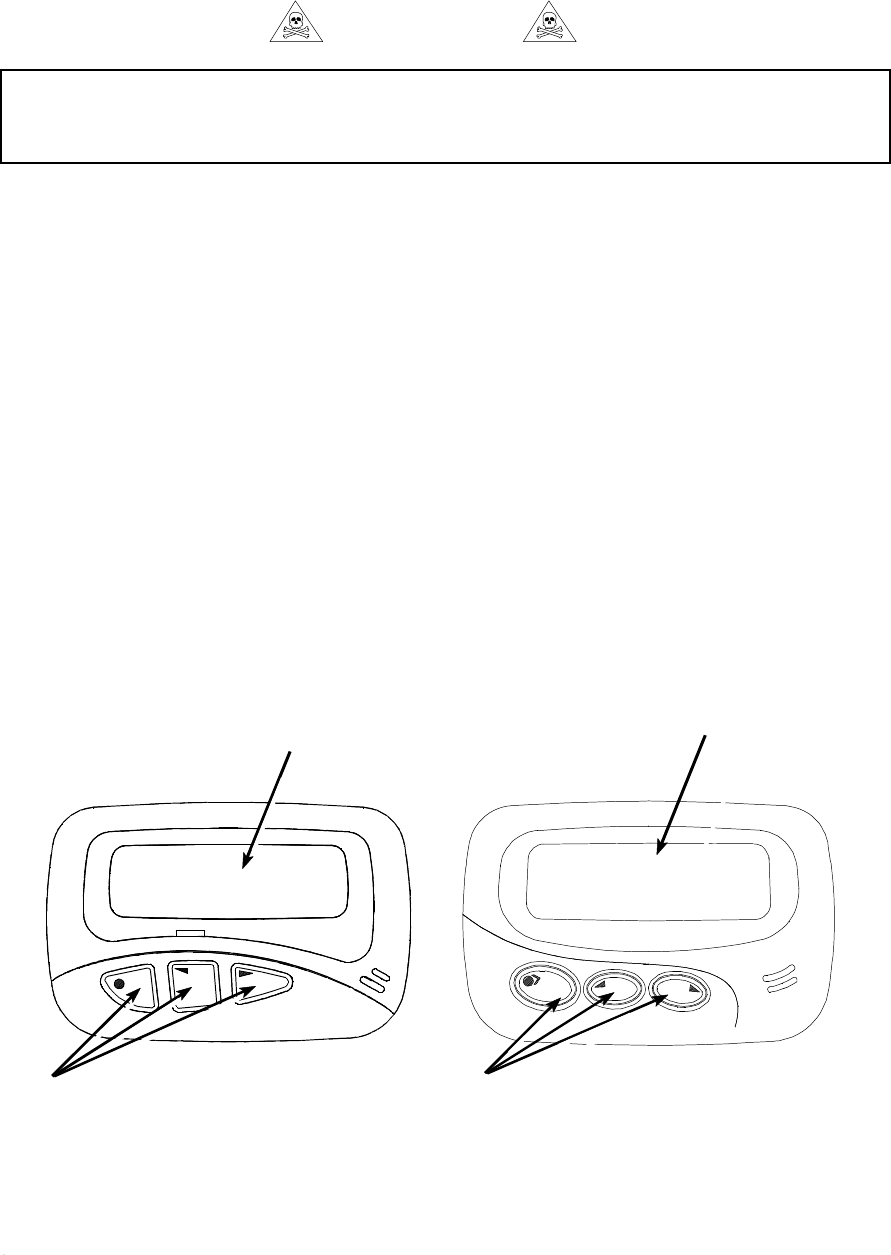
DISPLAY
CONTROL BUTTONS
TAG11268
>
DISPLAY
CONTROL BUTTONS
STYLE A STYLE B
TLA 852/FLA 872
TM1205 Issue 2 Page 2 - 3
DO NOT TAKE THE PAGER INTO AREAS WHERE EXPLOSIVE GASES, OR
DUST MAY BE PRESENT.
Figure 2.1: Controls and Display
WARNING
CAUTION
PROTECT THE PAGER FROM LIQUIDS, STRONG MAGNETIC FIELDS AND
EXTREME TEMPERATURES. DO NOT LEAVE THE PAGER EXPOSED TO
STRONG SUNLIGHT.
2.1 CONTROLS AND INDICATORS
Refer to Figure 2.1 for the identification and location of the controls and display
associated with the TLA 852 and FLA 872.
Note: In Germany, Style A (aerofoil) case is only for T Mobile use.
In the United Kingdom, Style B (oval) case is only for use by Vodafone Paging.

5:27 pm 25 .12 .98
TLA 852/FLA 872
TM1205 Issue 2Page 2 - 4
Figure 2.2: Standby Screen
2.1.1 Display
The Liquid Crystal Display (LCD) in the TLA 852 shows two lines of characters. The
FLA 872 shows four lines of characters (or two lines of double height characters) . Each
line can have a maximum of 20 characters. Both units can also show a maximum of
seven symbols in a line. Lamps (Electro-luminescent (EL) option also available - FLA
Series only) are incorporated in the unit, to illuminate the display when required.
2.1.2 Controls
The three push-buttons have these functions:
O> Selects the unit functions
Moves the cursor to the left
Moves the cursor to the right
2.2 OPERATING INSTRUCTIONS
2.2.1 General
The operation of most functions of the TLA 852 and the FLA 872 is identical. Where
differences occur, both operations are described.
2.2.2 Switching the Unit ON
When the battery is installed in the unit, the display shows the time and date on the
bottom line and the status symbols on the top line. The display stays on until the
battery is removed or the ‘OFF’ mode is selected.
If the unit is in the ‘OFF’ mode, push and hold the O> button until the Audio and
Vibrate Alerts operate. The display then shows a message for a short time before
the time and date show. This is the ‘standby’ screen.
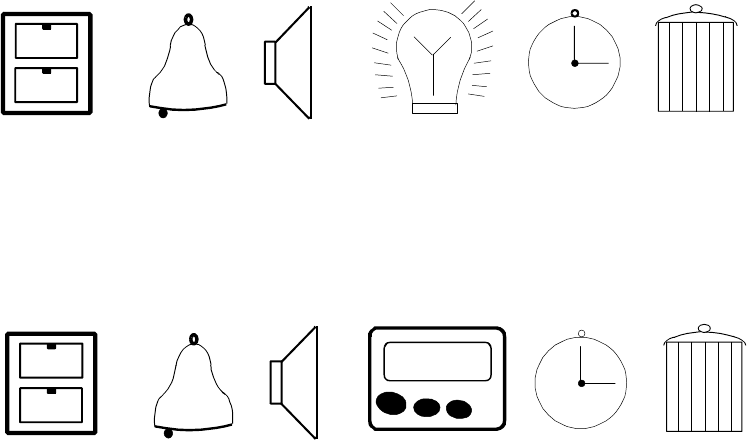
ARCHIVE ALERT BACKLIGHT SET TIME DELETE
MESSAGES OFF
ALARM
TAG11216-1
Z
Z
Z
ARCHIVE ALERT DISPLAY SET TIME DELETE
MESSAGES OFF
ALARM
TAG11264-1
Z
Z
Z
TLA 852/FLA 872
TM1205 Issue 2 Page 2 - 5
TLA 852 Option Screen
FLA 872 Option Screen
Figure 2.3: Option Screen Symbols
2.2.3 Setting the Options
Make sure that the unit is ON and that the display shows the standby screen.
Push and release the O> button. The display will show seven symbols. These are:
Push the Í or theÌ button to choose the required symbol (the symbol flashes as it
is chosen) then push the O> button to select the function.
Paragraphs 2.2.4 through 2.2.12 give the function and operation of each symbol.

TLA 852/FLA 872
TM1205 Issue 2Page 2 - 6
2.2.4 Archive
a) General
The operator can use this option to archive received messages and also to view
messages in the archive store.
b) Archiving Messages
Select the required message and view the complete message by pressing the
O> button. After the last screen of the message is displayed, push the Í or
theÌ button to choose the archive symbol.
When the archive symbol flashes, push the O> button. The display shows the
archive symbol plus a flashing ?. Push the O> button again to transfer the
message to the archive memory.
If the archive is full, the ‘memory full’ symbol will flash. A message must
be deleted from the archive memory before the new message can be saved.
c) Viewing Archived Messages
To view the messages in the archive memory select the archive symbol on the
options screen and push the O> button. Push theÌ button to select the most
recent message. Push the Í or theÌ button to scroll through the messages.
If the message is more than one screen long push the O> button to display the
next screen.
NOTE: If there are no information services available in the unit, push theÌ
button to select the archive directly from the standby screen.
To return to the standby screen, push and hold the O> button for one second
or wait for the unit to time-out and show the standby screen.
2.2.5 Alarm
The alarm can be set to operate once at any time in a twenty four hour period. To
set the alarm, first select the alarm function on the option screen as shown in
paragraph 2.2.3.
Use the ¬ or - buttons to choose the alarm ON or alarm OFF symbol.
When the alarm is set to OFF, the symbol shows and the alarm time is not
shown.

TLA 852/FLA 872
TM1205 Issue 2 Page 2 - 7
When the alarm is set to ON and the alarm time is reached, the standby screen will
show a flashing alarm symbol and the alert will operate for eight seconds. To stop
the alert within the eight second period, push any button.
To set the alarm time, set the alarm to ON. The display shows the alarm symbol and
also shows the time the alarm is set to sound.
To change the time:
a) Push the O> button and the hour numbers flash. Use the ¬ or - buttons to
set the required hour.
b) Push the O> button again and the tens of minutes number flashes. Set the
required figure with the ¬ or - buttons, then push the O> button to make the
minutes number flash. Set the required figure with the ¬ or - buttons.
c) To return to the standby screen, push and hold the O> button for one second
or wait for the unit to time-out. The screen now shows the alarm symbol to
indicate that the alarm is set.
2.2.6 Alert
The alert can be set to one of nine options; seven audible, vibrate or ‘no alert’.
To set the alert, first select the alert function on the option screen as shown in
paragraph 2.2.3
a) When the alert screen shows, use the ¬ or - buttons to select an alert (as
each alert is selected, the associated tone sounds or the vibrate operates. To
stop the alert, push any button).
b) When the required alert is selected, push the O> button for one second or wait
for the unit to timeout.
c) The display returns to the standby screen and shows the alert symbol.
If the vibrate alert is selected, the display shows
When the audible alert is selected, the display shows
When ‘no alert’ is selected, the display shows
The alert can be quickly set ON or OFF from the standby screen by pushing and
holding the O> button for three seconds.

TLA 852/FLA 872
TM1205 Issue 2Page 2 - 8
2.2.7 Display Backlight (TLA 852)
The unit display has a backlight which allows the display to be read in low-light
conditions.
To operate the backlight, first select the backlight function on the option screen as
shown in paragraph 2.2.3
When the backlight screen shows, use the ¬ or - buttons to select the backlight
ON or OFF.
To return to the standby screen, push and hold the O> button for one second or wait
for the unit to time-out.
2.2.8 Display Options (FLA 872)
Choose this option to show the display options screen. This shows two options :
a) To change the height of the message characters ABC (refer to paragraph 2.2.9)
b) To operate the backlight (refer to paragraph
2.2.10)
2.2.9 Changing the Height of the Characters
When the display option screen is selected, the screen shows the two symbols with
the ABC symbol flashing.
There are two heights of character available; single height, which allows four lines
of a message to show on the screen, and double height, which shows two lines of
a message in large characters.
To change the character height, push the ¬ or - buttons until the required height
shows on the screen.
To return to the standby screen, push and hold the O> button for one second or wait
for the unit to time-out.
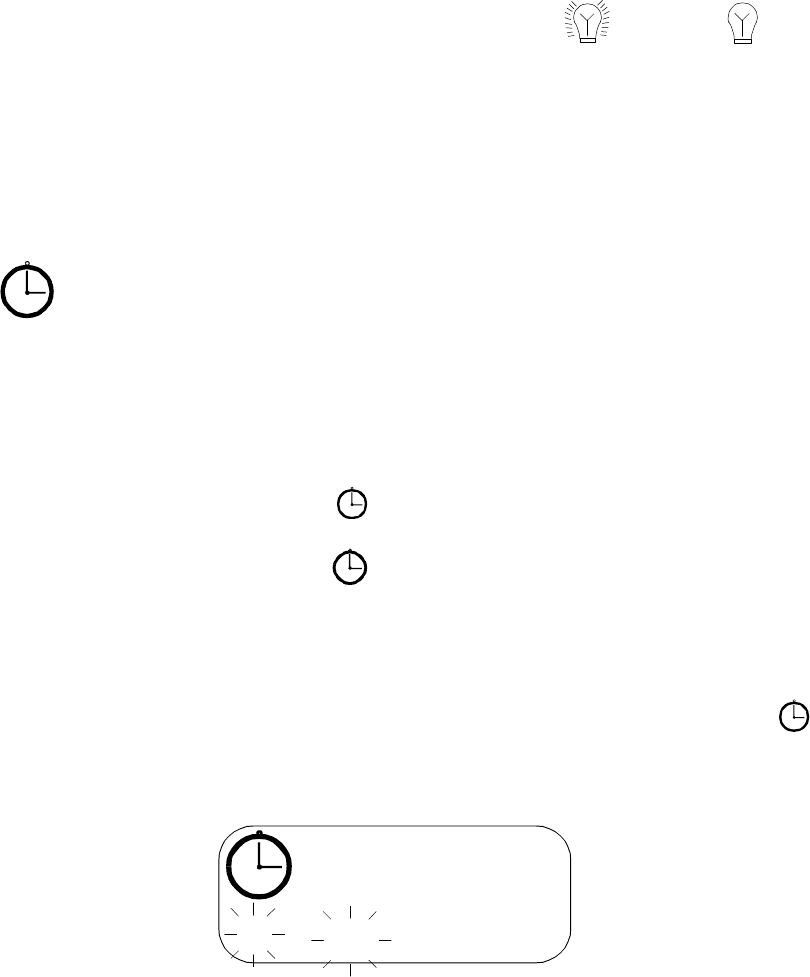
5:27pm
12
25.12.98
Z
Z
TLA 852/FLA 872
TM1205 Issue 2 Page 2 - 9
2.2.10 Display Backlight (FLA 872)
Select the display option screen, then push the O> button to choose the backlight
function.
Use the ¬ or - buttons to select the backlight ON or OFF .
To return to the standby screen, push and hold the O> button for one second or wait
for the unit to time-out.
2.2.11 Setting the Time and Date and Timed-off Time
To set the time and date or the timed-off time, first select the set time function on the
option screen, as shown in paragraph 2.2.3 The set time screen then shows two
options:
a) Setting Time and Date (Refer to paragraph A).
b) Setting Timed-off Time (Refer to paragraph B).
A) Setting Time and Date
a) Use the ¬ or - buttons to choose the Setting Time and Date symbol then
push the O> button.
b) The screen shows the time and date with the hour numbers flashing. If the
clock is set to the 12 hour mode, the ‘am/pm’ characters also flash.
c) Use the ¬ or - buttons to set the required hour.

Z
Z
TLA 852/FLA 872
TM1205 Issue 2Page 2 - 10
d) Push the O> button again and the tens of minutes number flashes. Set the
required figure with the ¬ or - buttons.
e) Push the O> button to make the minutes number flash. Set the required figure
with the ¬ or - buttons.
f) Push the O> button again and the date ‘day’ numbers flash. Use the ¬ or -
buttons to set the required figures.
g) Push the O> button again and the ‘months’ numbers flash. Set the required
figure with the ¬ or - buttons.
h) Push the O> button again to make the ‘year’ numbers flash. Set the required
figure with the ¬ or - buttons.
i) Push the O> button to select the 12 or 24 hour mode. Use the ¬ or - buttons
to set the required mode.
j) When the display shows the required time and date, push the O> button for
one second to return to the standby screen, or wait for the unit to time-out.
B) Setting Timed-off Time
This option sets the pager OFF and ON at preset times (e.g. overnight). To select
this option :
k) Select the Set Time screen as shown in paragraph 2.2.11.
l) Use the ¬ or - buttons to choose the symbol then push the O> button.
The display shows the Timed-off edit screen.
m) To set the Timed-off option to OFF, push the ¬ or - buttons until the start
and stop times do not show.
n) To set the Timed-off option to ON, push the ¬ or - buttons until the start and
stop times show on the display.
o) To change the START and STOP times:
i) Set the Timed-off option to ON, then push the O> button. The first
numbers (Start Time hours) flash. If the clock is set to the 12 hour mode,
the ‘am/pm’ characters also flash.

Z
11:15pm 6:45am
Z
TLA 852/FLA 872
TM1205 Issue 2 Page 2 - 11
ii) Push the ¬ or - buttons to select the required hour.
iii) Push the O> button to select the next number (tens of minutes) then push
the ¬ or - buttons to select the required number.
iv) Push the O> button again to select the next number (minutes) then push
the ¬ or - buttons to select the required number.
v) Push the O> button again to select the next number (Stop Time hours).
vi) Repeat operation ii) through iv) to set the required Stop Time hours and
minutes.
vii) To return to the standby screen, push and hold the O> button for one
second or wait for the unit to time-out.
2.2.12 Deleting Messages
a) Deleting Stored or Archived Messages
To delete any message in the store or archive memories of the pager.
Select the message with the ¬ or - buttons. Use the O> button to read the
complete message.
When the last screen is displayed, push the O> button then use the ¬ or -
buttons to select the delete symbol.
Push the O> button. The display shows the delete symbol plus a flashing ?
Push the O> button to delete the message.

Z
Z
Z
Z
Z
Z
TLA 852/FLA 872
TM1205 Issue 2Page 2 - 12
b) Deleting All Stored Messages
All the messages in the store memory (but not those in the archive memory) can
be deleted in one operation.
Push the O> button to show the seven option symbols.
Use the ¬ or - buttons to choose the symbol.
Push the O> button to select the function.
The display shows the symbol plus a flashing ? symbol.
Push the O> button to delete all the messages.
2.2.13 Switching the Unit OFF
The pager can be switched OFF (sleep mode) but the pager cannot receive
messages while it is set to this state.
To switch the pager OFF, select the OFF function on the option screen as shown in
paragraph 2.3.3
The display shows the symbol plus a flashing ? symbol.
Push the O> button to set the pager to OFF.
The screen goes blank.

TLA 852/FLA 872
TM1205 Issue 2 Page 2 - 13
2.3 RECEIVING AND STORING MESSAGES
2.3.1 Receiving a Message
When the pager receives a new message the first part of the message shows on the
display and the alert operates for eight seconds.
Push any button to acknowledge receipt of the message and to stop the alert.
If the call is not acknowledged the pager will give a short alert every five minutes for
a maximum period of one hour.
To display the message, push the - button. If the message is longer than the
screen can show, push the O> button to show the next part of the message.
To return to the standby screen, push and hold the O> button for one second or wait
for the unit to time-out. If the message has not been read, the standby screen will
show the ‘message’ symbol.
2.3.2 Reviewing Stored Messages
To display the received messages, starting with the newest message, push the
- button. To scroll through the messages, use the ¬ or - buttons. If the
message is longer than the screen can show, push the O> button to show the next
part of the message.
When the last part of the message is shown, push the O> button. The display shows
three symbols:
To read the message again, use the ¬ or - buttons to select the first symbol then
push the O> button.
To delete the message, use the ¬ or - buttons to select the second symbol then
push the O> button. The display shows the delete symbol plus a flashing ? symbol.
Push the O> button again to delete the message.
To put the message in the Archive Store, use the ¬ or - buttons to select the third
symbol then push the O> button. The display shows the archive symbol plus a
flashing ?. Push the O> button again to transfer the message to the Archive Store.
To return to the standby screen at any time, push and hold the O> button for one
second or wait for the unit to time-out.

TLA 852/FLA 872
TM1205 Issue 2Page 2 - 14
The unit memory can hold a maximum of 20 messages. When this number is
reached the standby screen shows the memory full symbol.
If a new message is received when the memory is full, the oldest message is
deleted.
2.3.3 Archiving Messages
Messages can be protected by transferring them to the Archive Store. Refer to
paragraph 2.3.4 or paragraph 2.4.2. for the procedure.
2.3.4 Reviewing Information Service Messages (Optional Feature)
When this feature is available, the standby screen shows the symbol when the
pager receives an Information Service message.
To select the Information Service menu, push the ¬ button when the screen shows
the standby display.
The information menu screen shows a maximum of eight number symbols, each
enclosed within a circle. Numbers which have unread Information Service messages
have a thicker circle.
Use the ¬ or - buttons to choose the required service number then push the
O> button to show the message.
To review other messages on the same service, push the ¬ or - buttons until the
required message shows.
To return to the Information Services menu push the O> button repeatedly until the
menu shows.
To put an information service message into the Archive Store, use the procedure
given in paragraph 2.3.4.
2.3.5 No Service (Optional Feature)
When this feature is available, the standby screen shows the No Service symbol if
the pager cannot receive signals from the paging network.
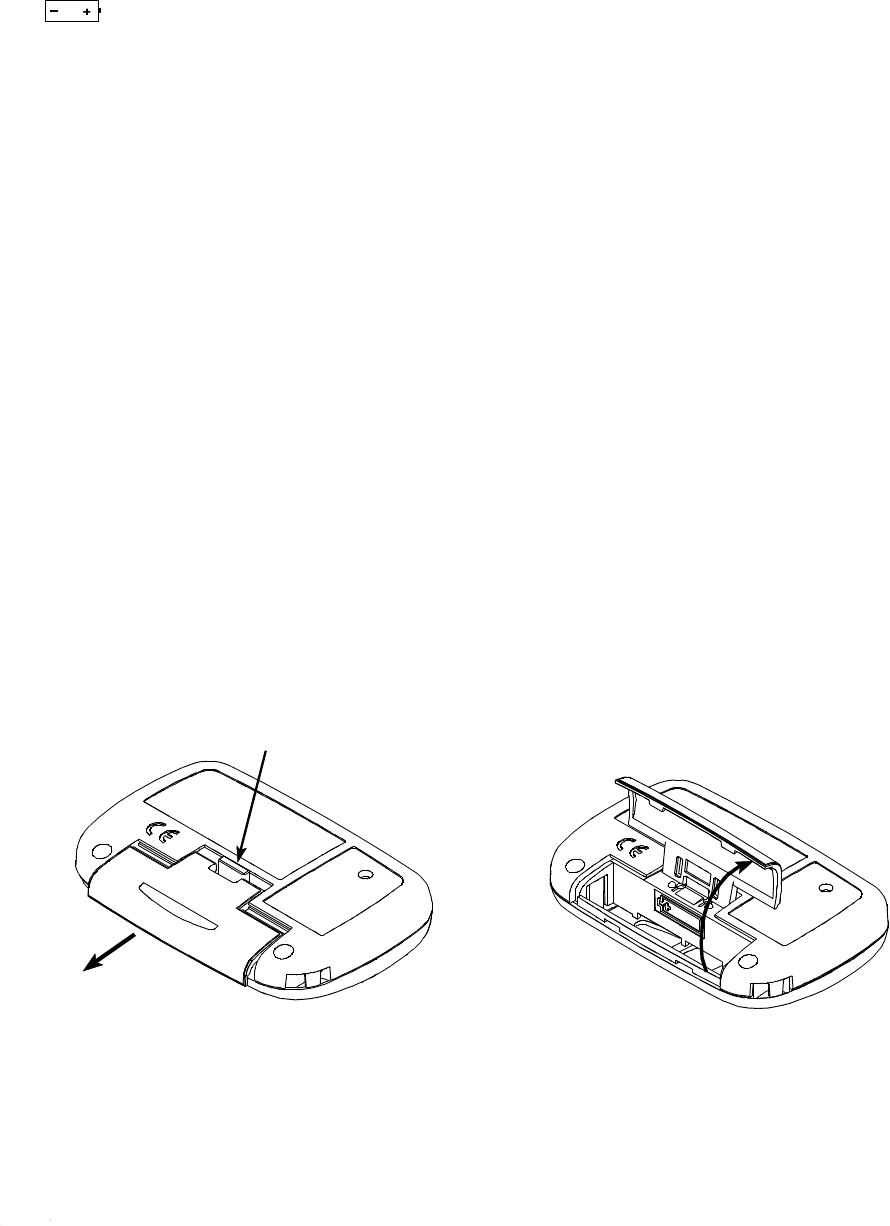
AB
PUSH THE LONG EDGE OF THE
BATTERY DOOR UPWARDS TO OPEN IT
PUSH THE DOOR LOCK TO
RELEASE THE BATTERY DOOR
SLIDE THE BATTERY DOOR
FORWARD
TAG11126-1
TLA 852/FLA 872
TM1205 Issue 2 Page 2 - 15
Figure 2.4: Opening the Battery Door
2.4 LOW BATTERY
2.4.1 Low Battery Warning
When the battery needs replacing, the pager sounds an alert and the low battery
symbol shows on the standby screen.
2.4.2 Replacing the Battery
a) Refer to Figure 2.4. Use a thumbnail to press down on the battery door lock on
the back of the unit. Hold the door lock down and push the battery door in the
direction shown. Rotate the door as shown in Figure 2.4 to gain access to the
battery.
b) Remove the old battery.
c) Refer to the diagram in the battery compartment and install the new battery.
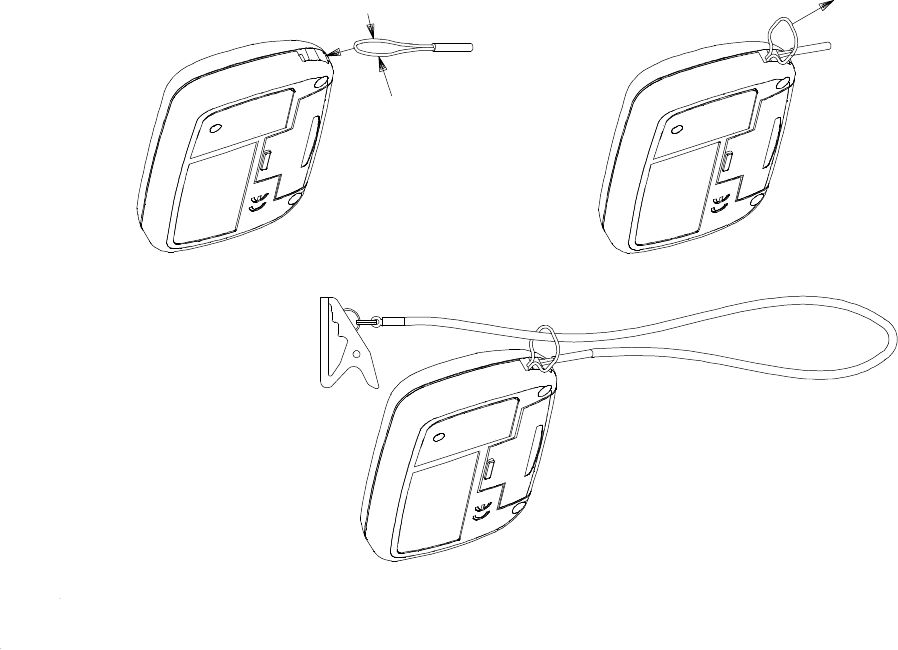
STAGE 1
SQUEEZE THE LOOP TOGETHER
AND PUSH IT INTO THE SLOT
STAGE 2
PULL THE LOOP THROUGH THE SLOT
AS FAR AS POSSIBLE
STAGE 3
FEED THE CLIP THROUGH
THE LOOP AND PULL TIGHT
TAG11261-1
TLA 852/FLA 872
TM1205 Issue 2Page 2 - 16
Figure 2.5: Lanyard Assembly
2.5 LANYARD ASSEMBLY
Figure 2.5 shows the method of assembling the lanyard to the unit.
TLA 852/FLA 872
TM1205 Issue 2 Page 3 - 1
SECTION 3
TECHNICAL DESCRIPTION
CONTENTS: Page
3.1 CIRCUIT SUMMARY 3 - 2
3.2 DUAL CONVERSION RECEIVER 3 - 4
3.3 DECODER 3 - 7
3.3.1 General 3 - 7
3.3.2 POCSAG Decoder 3 - 7
3.3.3 Microprocessor 3 - 8
3.3.4 EEPROM 3 - 8
3.3.5 SRAM 3 - 8
3.3.6 LCD Module 3 - 8
3.3.7 Display Illumination 3 - 9
3.3.8 Alerts 3 - 9
3.4 POWER SUPPLIES 3 - 9
FIGURES:
3.1 TLA 852/FLA 872 Block Diagram 3 - 2
3.2 Receiver Block Diagram 3 - 4
3.3 Decoder Block Diagram 3 - 7
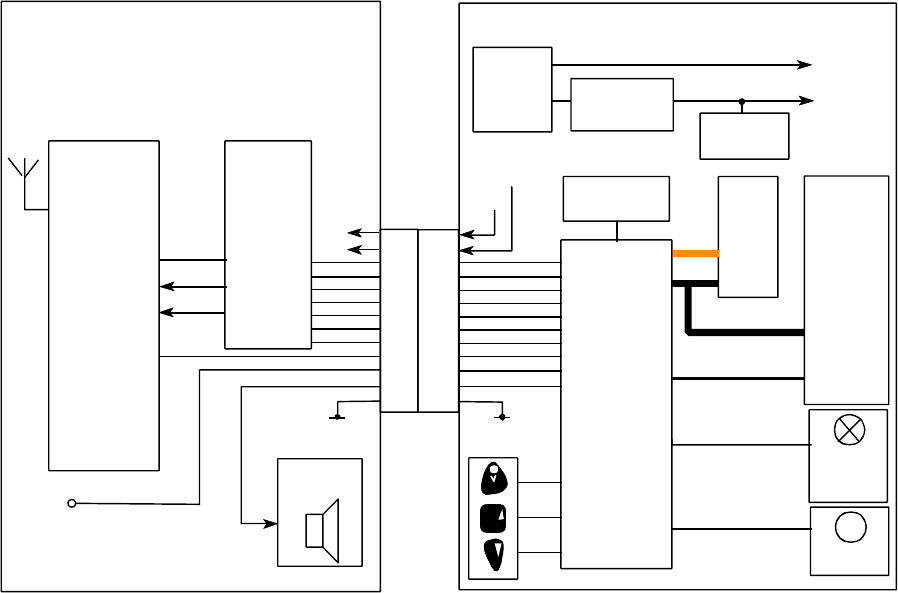
RADIO BOARD DECODER BOARD
AUDIBLE
GND
BATTERY
CONVERSION
RECEIVER
DUAL
DECODER
POCSAG
CONVERTER
SUPPLY
VOLTAGE
BACK-UP
DISPLAY
ILLUMI-
LIQUID
EEPROM
CRYSTAL
DISPLAY
MODULE
SRAM
M
VIBRATE
MOTOR
MICRO-
PROCESSOR
B+
VDD
PL401 SK1
DATA
TAG11262-1
DATA
ADDR
CONTROL
B+
VDD
VDD
B+
PROG ALERT
GND
RXEN
CHG
LOBAT
NATION
TLA 852/FLA 872
TM1205 Issue 2Page 3 - 2
Figure 3.1: TLA 852/FLA 872 Block Diagram
3.1 CIRCUIT SUMMARY
The TLA 852 and FLA 872 radio paging receivers each consist of two Printed Circuit
Board (PCB) assemblies contained in a plastic case.
The case is constructed in two main parts, the case front and the case back. A cover
on the back of the unit provides access to the battery compartment.
The two boards in the case are:
a) The Radio Board which has the Dual Conversion Receiver, the POCSAG
Decoder, the 1 volt regulator and the audio alert output circuit and transducer.
b) The Decoder Board which has the microprocessor, the EPROM, the SRAM, the
Liquid Crystal Display Module, the LCD illumination, the vibrate motor and the
primary and backup power supplies.
The block diagram of the functional areas of the units is shown in Figure 3.1. Refer
to Section 7 for the circuit diagrams and board layout information.
TLA 852/FLA 872
TM1205 Issue 2 Page 3 - 3
The RF signal enters the aerial and is fed to the dual conversion superheterodyne
receiver. The signal is demodulated from RF to audio frequency digital form and is
then fed to the decoder. This results in the received data activating the memory,
display and the selected audible alert or vibrate alert.
To prolong the life of the battery, the receiver operates in battery economy mode.
When the unit is in standby mode, the receiver is powered up at regular intervals
(equivalent to once per batch) to allow the POCSAG decoder to search for
pre-amble. While the unit is receiving preamble on its allocated channel, the
receiver remains powered up. This allows the POCSAG decoder to search for a
SYNC word. When the SYNC word is found, ‘batch lock’ is achieved. In batch lock
the receiver is only powered up during the allocated frame to allow the POCSAG
decoder to search for its address. If the address is found, the receiver stays ON for
the duration of the message.
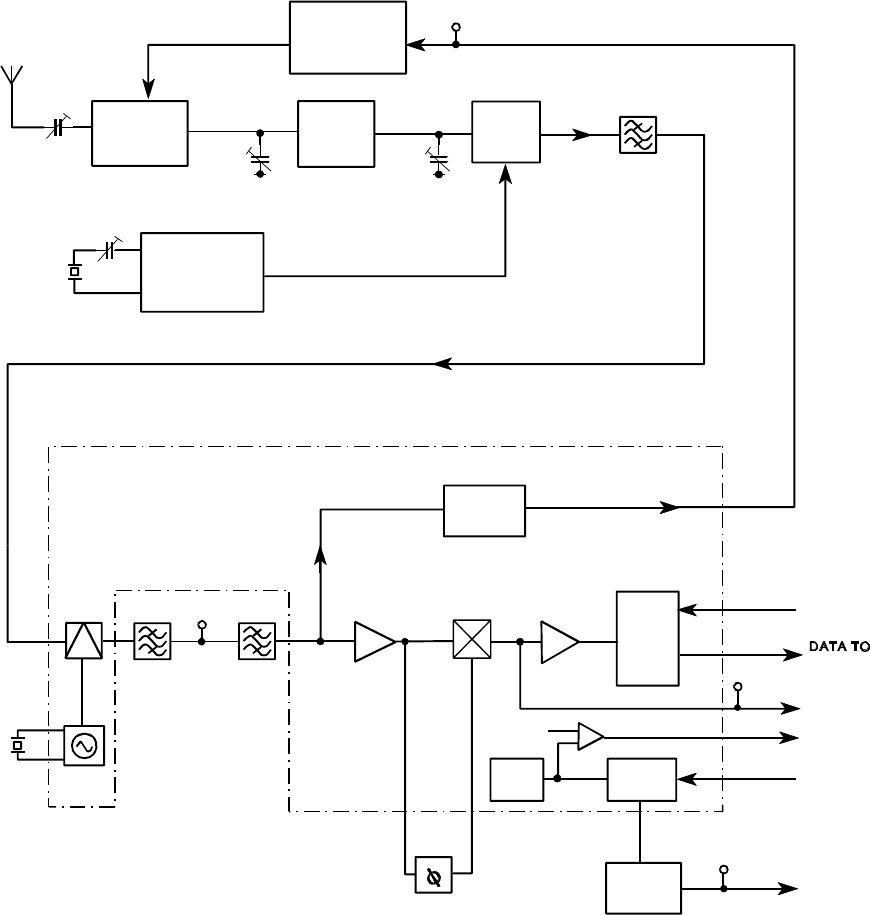
TAG11263-1
RF AMPLIFIER
TR403
MIXER
AE401
AE402
2nd OSC.
MIXER
455kHz
TR401, TR402
21.4 MHz
CER
FL402
IC401
MIXER, IF AMP & DET.
TR410
1st OSC.
FL401
IF AMP
XL402
XL401
455kHz
CER
FL403
CV404
(OPTIONAL)
TR404 TP403
IMAGE
FILTER
GND GND
CV407 CV406
CV405
TP405
RSSI
DET
DELAY
FL404
DECODER
TP401
SINAD
FSK
COMP.
FILTER QUICK
CHARGE
AMP
PHASE
1V
REG
TR406 1V
SUPPLY
1V
TP402
INT.
REF. RXEN
LOWB
AGC CONTROL
TLA 852/FLA 872
TM1205 Issue 2Page 3 - 4
Figure 3.2: Receiver Block Diagram
3.2 DUAL CONVERSION RECEIVER
The incoming RF signal is received by the aerial AE401/AE402 which is tuned by
CV404. Capacitors C401, C405 and inductor L416 provide matching to RF amplifier
TR401, TR402. The amplifier, typically, yields a voltage gain of 20 dB. R401 and
R402 provide DC bias.
TLA 852/FLA 872
TM1205 Issue 2 Page 3 - 5
The output from the RF amplifier passes through an image filter which provides these
functions:
a) Attenuation of signals outside the required band.
b) Attenuation of the first image frequency.
c) Matches the output impedance of the RF amplifier to the input impedance of the
mixer stage.
L401 and CV407 form a parallel tuned circuit with the resonant frequency set to the
carrier frequency.
L407 forms a series resonant circuit which provides a notch filter at the image
frequency.
The local oscillator comprises transistor TR410, crystal XL402 and associated
components. Frequency adjustment is by CV405. The local oscillator frequency is
calculated as follows:
fx = carrier frequency minus 21.4MHz
where fx is the crystal frequency in MHz.
C452, C453, C494 and R439 provide decoupling of the supply rail to give good
adjacent channel performance. The local oscillator signal is coupled to the mixer
circuit by C465.
The mixer circuit, TR403 and associated components, receives the RF output of the
image filter. The RF signal is mixed with the local oscillator output to produce a
21.4MHz product. This is matched to the filter, FL401, by L406, C495 and R412.
FL401 has a bandwidth of ±7.5kHz at the 3dB points.
The output from FL401 is matched by C485, R444 and L410 to IC401 pin 24. IC401
is a combined IF mixer / local oscillator / detector.
The second oscillator runs at 20.945MHz and, with the exception of XL401 and its
tuning capacitors C407, C408, is built into the IC. As the second oscillator is not
trimmed, small frequency errors are absorbed when tuning the first local oscillator.
The input at pin 24 is applied to the internal second mixer, and is mixed with the
second oscillator output to produce a 455kHz 2nd IF signal at pin 3. The IF signal
then passes through two ceramic filters FL403 and FL402 which remove unwanted
mixer products and provide further selectivity.
The output from FL403 is split: one output connects through C444 to pin 6 of IC401
and the IF amplifier; the other optionally connects to the Received Signal Strength
Indicator (RSSI) circuit in IC401 through C454, R426 and pin 5.
TLA 852/FLA 872
TM1205 Issue 2Page 3 - 6
Due to the characteristics of filters FL401, FL402 and FL403, the signal at the input
to the IF amplifier has amplitude modulation (AM). The AM must be removed before
the signal reaches the detector stage. This is performed by the IF amplifier in IC401
which has very high gain and is designed to limit the amplitude of the signal to
remove the AM component and give a ‘square’ output. C479 and C480 provide
de-coupling for the IF amplifier.
The output from the IF amplifier passes to the detector in IC401. This circuit is a
Quadrature Demodulator which has two inputs. One input connects directly to the
IF amplifier, the other receives the signal from the IF amplifier through a phase delay
circuit connected to pins 9 and 10 of the IC. The phase delay depends on the
frequency of the IF signal and is 90 degrees at the centre frequency of the unit’s
allocated channel. The phase shift is provided by ceramic discriminator FL404,
capacitor C426 and resistor R416. C425 is a de-coupling capacitor.
The RSSI circuit in IC401 provides an optional Automatic Gain Control (AGC) signal
for the receiver. The circuit detects the received signal strength and gives a DC
current out. R426 sets the level at which the circuit starts to operate. The value of
68 kilohms sets it to approximately 16 dB above the noise floor. The DC output from
pin 22 of the IC connects to the AGC control circuit. When there is no RSSI output,
transistor TR404 is biased off and keeps the RF amplifier at full gain. At strong
signal levels the output from the RSSI causes TR404 to gradually start conducting,
thus reducing the gain of the RF amplifier. C451 determines the rise and fall times
of the AGC.
The output from the detector stage, pin 11, gives an audio output to TP401. This test
point is used in the final stages of production to align the receiver circuits. TP 401
is also used to program the decoder section of the unit. Pin 11 of IC401 also
connects through R425, R429 and R428 to pin 12. These resistors together with
capacitors C448, C483, C484 and the internal filter amplifier of IC401 form the data
filter; a unity-gain, low-pass filter which reduces high frequency noise.
The output of the data filter connects internally to the FSK Comparator. The data
output of the comparator, from pin 18, connects to the POCSAG Decoder, IC402,
pin 4. A logic signal from IC402, pin 2 to IC401, pin 16 controls the Fast/Slow charge
of the FSK Comparator. At switch-on the logic level is high and the circuit is set to
Fast Charge to allow the voltage on capacitor C492 to be set to the voltage level on
C486. The logic level at pin 16 is then set low which sets the comparator to normal
operation.
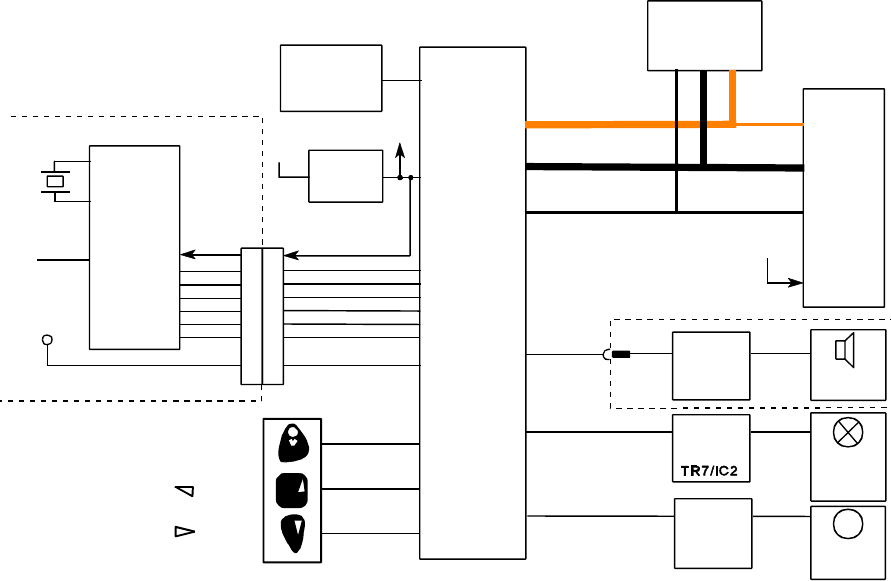
DISPLAY
M
VIBRATE
MOTOR
LIQUID
EEPROM
CRYSTAL
DISPLAY
MODULE
SRAM
AUDIBLE
ALERT
MICRO-
PROCESSOR
SK1
TAG11122-1
DATA BUS
ADDRESS
CONTROL LINES
DECODER
POCSAG
PL401
PGM
DATA
XL403
SW2
SW3
SW1
!>BUTTON
BUTTON
BUTTON
FROM
RECEIVER
BUS
RESET
IC5
VDD
IC1
IC3
IC402
RESET
DRIVER
DRIVER
TR415
TR3; TR4
TP401
DRIVER
TR2 OR
TR416
SK1 PL401
IC4
RESET
ILLUMI-
NATION
TLA 852/FLA 872
TM1205 Issue 2 Page 3 - 7
Figure 3.3: Decoder Block Diagram
3.3 DECODER
3.3.1 General
The Decoder comprises the POCSAG decoder, Microprocessor, EEPROM, SRAM
message memory and switches, plus support components and a separate LCD
module. The signal from the receiver is processed by IC402, the POCSAG decoder,
and the decoded data passed to the microprocessor. The microprocessor stores the
information in the SRAM, IC4, before activating the selected alert and sending the
message data to the LCD module for display. The EEPROM holds information
applicable to the unit.
3.3.2 POCSAG Decoder
The POCSAG decoder, IC402, is located on the Radio Board of the unit and
connects to the microprocessor, IC3, through PL40I / SK1. Pin 4 of IC402 receives
the data signal from IC401. IC402 decodes the information and sends it, four bytes
at a time, to the microprocessor, IC3. IC402 uses the SCK clock pulses from IC3,
pin 59, to transfer the data on the SDO line, IC402, pin 13.
When no signals are received by the unit, the system goes into a standby mode to
reduce power consumption. In this mode, a pulse from IC402 pin 1 (BS1), sets the
receiver circuits ON for a brief period every 0.5s - 1s, depending upon Baud rate, to
check for a preamble signal. If such a signal is received, followed by a valid address
and message, a signal is sent from IC402, pin 15 (ATTN) to alert the microprocessor.

TLA 852/FLA 872
TM1205 Issue 2Page 3 - 8
Pin 9 (CLK0) provides clock pulses to operate the microprocessor while it is in
standby mode.
Pin 11 (AREA) goes high when a valid signal is received.
Pin 14 (SDI) receives program information from the microprocessor.
Pin 2 (BS2) controls the ‘fast charge’ operation of the FSK comparator in IC401.
3.3.3 Microprocessor
The microprocessor controls the functions of the unit. A 4.19MHz clock, controlled
by XL2, provides the basic timing for the system.
Data received from IC402 is processed by the microprocessor and stored in the
SRAM chip, IC4. The microprocessor then causes the selected Alert to operate and
sends the message to the LCD module for display. Outputs from pin 5 (LCD-CS),
pin 39 (AD17), pin 38 (AD16) and pin 60 (WR) control the transfer of data to the LCD
module on the databus. Outputs from pins 2 and 7 control the operation of the audio
alert and the vibrate motor.
IC3 also controls the internal functions of the system, displaying the symbols and
changing the modes when selected by the three buttons on the front of the unit.
3.3.4 EEPROM
The EEPROM (IC1) holds information applicable to the unit, such as: Serial Number;
RIC codes; Radio parameters. The information is sent to the microprocessor through
the serial data link, pins 62, 63 and 64.
3.3.5 SRAM
The SRAM (IC4) is a 256k device which can store up to 32k of 8-bit information.
Address lines AD00 through AD14 and control lines RAM-CE and WR from the
microprocessor, control the flow of data in and out of the device on the databus.
3.3.6 LCD Module
The LCD Module produces the required characters and the symbols for the integral
display. Address lines AD16 and AD17 and control lines LCD-CS and WR from the
microprocessor, control the flow of data to the device on the databus.
TLA 852/FLA 872
TM1205 Issue 2 Page 3 - 9
C20 and C21 are part of the internal DC/DC converter of the module’s negative bias
supply.
R11, R12, R13, C17 and C22 through C25 are part of the circuit which controls the
voltage to the LCD driver.
3.3.7 Display Illumination
Two miniature lamps are used to illuminate the LCD display. The lamps are selected
ON or OFF using the buttons on the front panel. The ‘Lamp ON/OFF’ signal, which
comes from pin 8 of the microprocessor, controls transistor TR2 in the lamp circuit
of the TLA852, or TR7/IC2 for the EL display in the FLA 872.
3.3.8 Alerts
a) Audible Alert (Beep)
The transducer, SP401, and the driver circuits TR415 and TR416, are located
on the radio board. The audible alert signal from IC3, pin 2 connects to TR415
through SK1/PL401 pin14. The alert can be selected ON or OFF using the
buttons on the front panel.
b) Vibrate Alert
The vibrate motor is operated by transistors TR3 and TR4 on the decoder
board. The vibrate alert signal from IC3, pin 7 connects to pin 1 of TR3. The
alert can be selected ON or OFF using the buttons on the front panel.
3.4 POWER SUPPLIES
The primary power supply for the unit is a single 1.5 volt, AAA battery (BAT1). The
supply from the battery (B+) connects directly to the display illumination and vibrate
motor circuits, that require relatively high currents. B+ also connects to the radio
board through SK1/PL401, pin 9 and to the voltage converter, IC6, on the decoder
board.
IC6 and its associated components supply the +3.1 volts (VDD) for the unit. TR5, T1,
C9, C11, C26, R10 and D1 form an oscillator giving a frequency between 5kHz and
20kHz. The output is rectified by D1 and smoothed by C12. IC6 samples the voltage
and if it exceeds 3.1 volts, IC6 causes TR6 to switch off and stop the oscillator.
When the pager circuits take current, the voltage drops and the oscillator is turned
on again. This produces a sawtooth voltage on the 3 volt rail which gives less RF
noise than other converter circuits.
In addition to supplying the 3.1 volts, the circuit charges the backup supply (BAT2)
through resistor R6. Double diode D2 provides isolation for the two circuits.
TLA 852/FLA 872
TM1205 Issue 2Page 3 - 10
IC5 monitors the voltage of VDD and resets the decoder circuits if the voltage drops
to a level that would cause data corruption.
Transistor TR1, connected to pins 6 and 15 of IC3, detects the battery voltage. If
BAT1 is removed, the drop in B+ causes transistor TR1 to switch OFF which sets the
microprocessor to low-current mode. In this mode BAT2 supplies sufficient power
to keep the microprocessor and the SRAM operational for up to 60 minutes.
The 1 volt supply for the receiver circuits is provided by transistor TR406 and its
associated components. The circuit is a series regulator and is maintained within
specification by a control circuit in IC401.
TLA 852/FLA 872
TM1205 Issue 1 Page 4 - 2
SECTION 4
INSTALLATION AND COMMISSIONING
There are no installation and commissioning procedures for the Radio Paging Receiver
Models TLA 852 and FLA 872.
TLA 852/FLA 872
TM1205 Issue 2Page 4 - 2
INTENTIONALLY BLANK
TLA 852/FLA 872
TM1205 Issue 1 Page 5 - 2
SECTION 5
SERVICING
CONTENTS: Page
5.1 SERVICE POLICY 5 - 3
5.2 ROUTINE MAINTENANCE 5 - 3
5.3 WORKSHOP PROVISIONS 5 - 3
5.4 TEST EQUIPMENT, TOOLS AND ANCILLARIES 5 - 3
5.4.1 Test Equipment 5 - 3
5.4.2 Tools and Ancillaries 5 - 4
5.5 DISASSEMBLY 5 - 4
5.5.1 Case Removal 5 - 4
5.5.2 Board Assembly Removal 5 - 5
5.5.3 Board Separation 5 - 5
5.5.4 LCD Module Removal 5 - 6
5.5.5 Vibrate Motor Removal 5 - 6
5.5.6 Battery Contacts Removal 5 - 6
5.6 ASSEMBLY 5 - 7
5.6.1 Battery Terminal Installation 5 - 7
5.6.2 Vibrate Motor Installation 5 - 7
5.6.3 LCD Module Installation 5 - 8
5.6.4 Board Assembly 5 - 8
5.6.5 Board Assembly Installation 5 - 8
5.6.6 Case Assembly 5 - 8
5.7 FAULT FINDING 5 - 9
5.7.1 General 5 - 9
5.7.2 Fault Diagnosis 5 - 9
5.7.3 Power Supply Voltage Adjustment 5 - 9
5.7.4 Battery Low Circuit Test 5 - 10
5.8 RADIO ALIGNMENT PROCEDURE 5 - 22
5.8.1 Preparation 5 - 22
5.8.2 Alignment Procedure 5 - 22
5.8.3 Pager Sensitivity Measurement (Coarse) 5 - 24
5.8.4 Pager Sensitivity Measurement (Fine) 5 - 25
5.9 PROGRAMMING 5 - 25
5.9.1 General 5 - 25
5.9.2 Equipment 5 - 25
5.9.3 Procedure 5 - 25

TLA 852/FLA 872
TM1205 Issue 2Page 5 - 2
TABLES Page
5.1 Radio Board DC Voltage Levels 5 - 14
5.2 Radio Board Test Points 5 - 14
5.3 Decoder Board DC Levels 5 - 15
5.4 Decoder Board Test Sequence 5 - 15
5.5 IC3 Microprocessor Pin Connections 5 - 19
5.6 IC4 RAM Pin Connections 5 - 20
5.7 LCD Display Pin Connections 5 - 21
FIGURES:
5.1 Battery Door 5 - 4
5.2 Case Front Removal 5 - 5
5.3 Exploded View of Unit 5 - 7
5.4 Connections between Radio Board and Decoder Board 5 - 10
5.5 Fault Finding Guide (Sheet 1 of 3) 5 - 11
5.6 Fault Finding Guide (Sheet 2 of 3) 5 - 12
5.7 Fault Finding Guide (Sheet 3 of 3) 5 - 13
5.8 Decoder Board Waveforms 5 - 16
5.9 Display Module Waveforms 5 - 17
5.10 Semiconductor Connection Details 5 - 18
5.11 Radio Alignment Test Equipment 5 - 22
5.12 P671A Showing the Tuning Points 5 - 23
5.13 Configuration for Coarse Sensitivity Measurement 5 - 24
5.14 Polystyrene Block for TEM Cell Test - Dimensions 5 - 26
CAUTION
STATIC SENSITIVE DEVICES ARE USED IN THIS EQUIPMENT. TAKE CARE DAMAGE
IS NOT CAUSED TO THESE DEVICES BY HIGH LEVELS OF STATIC ELECTRICITY.
TLA 852/FLA 872
TM1205 Issue 2 Page 5 - 3
5.1 SERVICE POLICY
Except for Routine Maintenance, repairs are only to be performed by qualified
personnel in authorised workshops.
The unit can be repaired to component level. The display module is a disposable
item. If any screening cans are removed for access to components, they must be
refitted flush to the printed circuit board.
5.2 ROUTINE MAINTENANCE
This is limited to battery replacement and surface cleaning of the outer case. Clean
the case with a lint free cloth moistened with soapy water. Do not use spirit or other
solvents as they can damage the case.
5.3 WORKSHOP PROVISIONS
Repair workshops must be free from hostile radio interference or otherwise equipped
with Faraday cages. Suitable equipment must be available to remove and install the
surface mounted components which are used in this unit.
5.4 TEST EQUIPMENT, TOOLS AND ANCILLARIES
5.4.1 Test Equipment
The following test equipment is required:
!IBM PC or compatible personal computer
!Programming Software P669H
!P645 Test Encoder
!P645A POCSAG Test Encoder Software
!RF Signal Generator
!Oscilloscope
!Millivoltmeter with high impedance, low capacitance probe
!Alignment and Fault-Finding Jig P671, P671A, P671B
!SINAD Meter
!AC Millivoltmeter
!Digital Multimeter
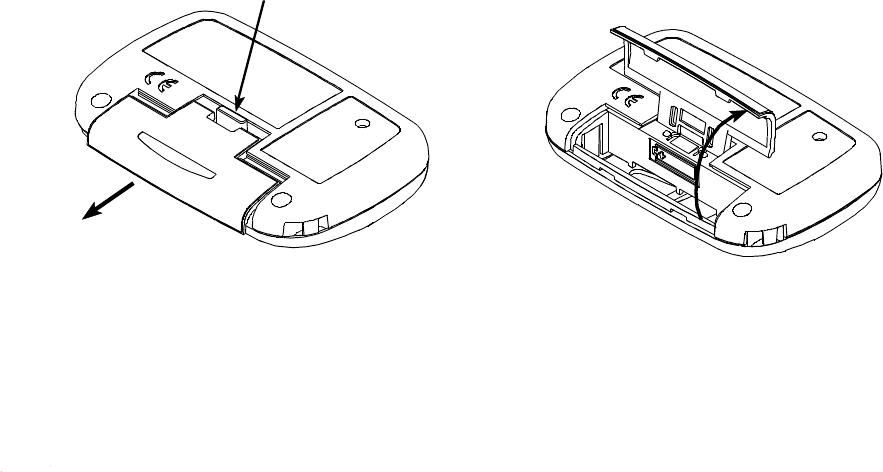
AB
PUSH THE LONG EDGE OF THE
BATTERY DOOR UPWARDS TO OPEN IT
PUSH THE DOOR LOCK TO
RELEASE THE BATTERY DOOR
SLIDE THE BATTERY DOOR
FORWARD
TAG11126-1
TLA 852/FLA 872
TM1205 Issue 2Page 5 - 4
Figure 5.1: Battery Door
5.4.2 Tools and Ancillaries
The following tools and ancillaries are required:
!DC Power Supply, 1-1.5 volts.
!Cross-point Screwdriver
!Surface Mount Handling Tools
!Anti-static Workstation
5.5 DISASSEMBLY
5.5.1 Case Removal
a) Refer to Figure 5.1. Use a thumbnail to press down on the battery door lock on
the back of the unit. Hold the door lock down and push the battery door in the
direction shown. Rotate the door as shown in Figure 5.1 to get access to the
battery.
b) Remove the battery.
c) Remove the two, 2.2mm x 6mm cross-head screws from the Case Back.
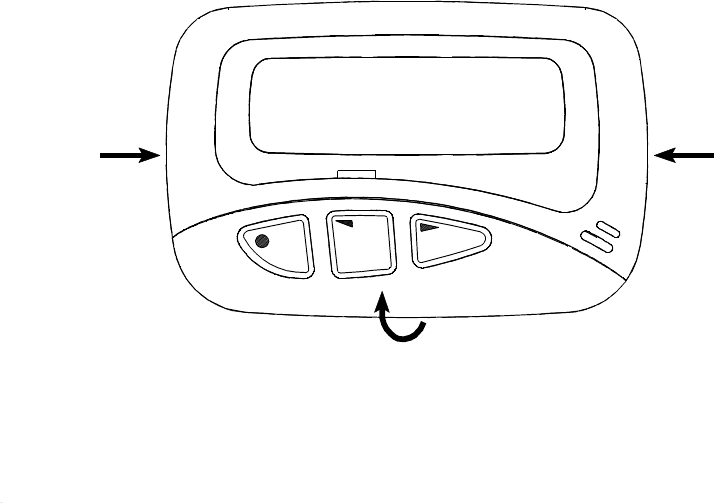
APPLY PRESSURE
WITH FINGERS
TO SIDES OF CASE
LIFT FRONT EDGE OF CASE FRONT
UNTIL REAR CATCHES DISENGAGE
TAG11213-1
>
TLA 852/FLA 872
TM1205 Issue 2 Page 5 - 5
Figure 5.2: Case Front Removal
d) Remove the Case Back by applying pressure to the sides of the case, as shown
in Figure 5.2, and lifting the front edge of the Case Front until the rear catches
disengage.
5.5.2 Board Assembly Removal
a) Remove the Case Back (see paragraph 5.5.1).
b) Carefully lift the Board Assembly at the long edge next to the LCD Module.
When the edge of the Board Assembly is clear of the case, pull the assembly
away from the case.
5.5.3 Board Separation
a) Remove the Board Assembly from the case (see paragraphs 5.5.1 and 5.5.2).
b) Carefully pull the front edge of the boards apart to disconnect the connector
between the boards.
c) Pull the Decoder Board forward to release the LCD Module from under the
aerial.
d) To get access to the Radio Board components, remove the rubber mat.
TLA 852/FLA 872
TM1205 Issue 2Page 5 - 6
5.5.4 LCD Module Removal
a) Remove the Board Assembly from the case (see paragraphs 5.5.1 and 5.5.2)
and separate the Decoder Board from the Radio Board (see paragraphs 5.5.3.,
a) through c)).
b) Release the two module pins from the holes in the Decoder Board and carefully
fold the module away from the board to get access to the flexible cable.
c) Use the Anti-static Workstation and the correct soldering tools to disconnect the
flexible cable from the board.
5.5.5 Vibrate Motor Removal
a) Remove the Board Assembly from the case (see paragraphs 5.5.1 and 5.5.2)
and separate the Decoder Board from the Radio Board (see paragraphs 5.5.3.,
a) through c)).
b) Use the Anti-static Workstation and the correct soldering tools to disconnect the
two wires from the board.
c) Use a screwdriver to lever the Vibrate Motor carefully from the clip.
5.5.6 Battery Contacts Removal
a) Remove the Board Assembly from the case (see paragraphs 5.5.1 and 5.5.2).
b) Pull the contacts out of their slots in the Case Back.
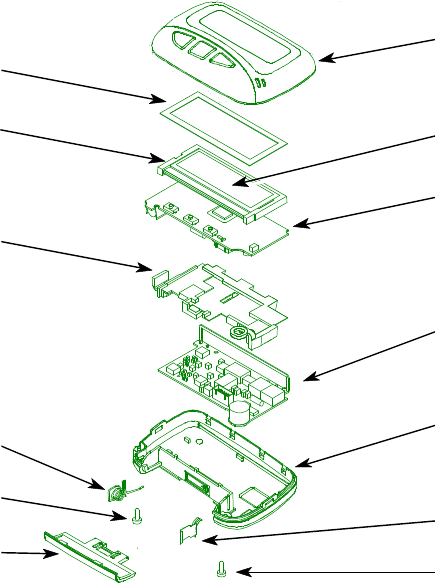
3
1
TAG11214-1
2
4
5
6
7
11
13
10
9
8
12
TLA 852/FLA 872
TM1205 Issue 2 Page 5 - 7
1. Case Front Assembly
2. LED Display
3. Decoder Board Assembly
4. Radio Board Assembly
5. Case Back Assembly
6. Battery Positive Contact
7. Case Fixing Screw
8. Battery Door
9. Case Fixing Screw
10. Battery Negative Contact
11. Rubber Mat
12. Moulding Bezel LCD
13. Display Gasket
Figure 5.3: Exploded View of Unit
5.6 ASSEMBLY
5.6.1 Battery Terminal Installation
a) Refer to Figure 5.3 for the correct orientation of the terminal.
b) Push the terminal into the slot in the Case Back.
5.6.2 Vibrate Motor Installation
a) Install the Vibrate Motor in the clip.
b) Use the Anti-static Workstation and the correct soldering tools to connect the
two wires to the Decoder Board.
TLA 852/FLA 872
TM1205 Issue 2Page 5 - 8
5.6.3 LCD Module Installation
a) Use the Anti-static Workstation and the correct soldering tools to connect the
flexible cable to the Decoder Board.
b) Carefully fold the flexible cable and install the two pins on the rear of the
module in the holes on the Decoder Board.
5.6.4 Board Assembly
a) Make sure that the Rubber Mat is correctly installed on the Radio Board.
b) Put the Decoder Board on the Rubber Mat. Make sure that the four small
extensions at the rear of the LED Module are located under the aerial.
c) Align SKT1 with PL401 and carefully press the two boards together until the
connectors are fully connected.
5.6.5 Board Assembly Installation
a) Slide the Board Assembly into the Case Back.
b) Make sure that the Battery Connector ‘fingers’ are in the correct position
under the Decoder Board.
c) Push down on the front edge of the board and slide the board under the
small extensions on the Case Back.
d) Push the rear edge of the Board Assembly into the Case Back.
5.6.6 Case Assembly
a) Install the Case Front on the Case Back by applying pressure to the sides of
the case and pushing the rear edges of the case together until the catches
snap in place.
b) Install the two 2.2mm x 6mm screws in the Case Back.
c) Open the Battery Door and install the battery.
d) Close the Battery Door and push it towards the top of the unit until it locks.
TLA 852/FLA 872
TM1205 Issue 2 Page 5 - 9
5.7 FAULT FINDING
5.7.1 General
Refer to the Fault Finding Guide (Figures 5.5 through 5.7) and the information
given in Tables 5.1 through 5.8 and Figures 5.8 through 5.10 to help resolve
problems. Alignment information is in paragraph 5.8. Programming information is
given in paragraph 5.9.
Faults can be caused by user negligence. Always check the unit for these faults:
a) Damage to the Case or LCD
b) Water damage
c) Corrosion damage or leaking battery
Any metal parts which are corroded must be removed. Clean the affected area of
the Board assembly with a non-corrosive contact cleaner. Dry the area with a
low-pressure flow of warm air (40 EC through 50 EC). Install new parts.
5.7.2 Fault Diagnosis
Put a known good battery in the unit and switch ON the unit. Refer to the Fault-
Finding Guide (Figures 5.5 through 5.7). If it is suspected that the Decoder Board
is faulty, proceed as follows:
a) Remove the Board Assembly from the case (see paragraphs 5.5.1 and
5.5.2).
b) Separate the Decoder Board from the Radio Board (see paragraph 5.5.3).
c) Disable the Battery Economy function by fitting a 0 ohm resistor in the
position for R456 (side 2 of the radio board near IC402).
d) Use the 14-way lead (supplied with the P671B) to connect the two boards
(refer to Figure 5.4)
e) Put the boards on an anti-static mat and connect a 1.5 volt supply to the
Decoder Board. Switch ON the power supply.
f) Connect a ’10-times’ probe to the oscilloscope and measure the points given
in Table 5.4. Compare the waveforms on the oscilloscope with those shown
in Figure 5.9.
5.7.3 Power Supply Voltage Adjustment
There is no adjustment for the 1 volt, 1.5 volts or 3 volts power supplies.
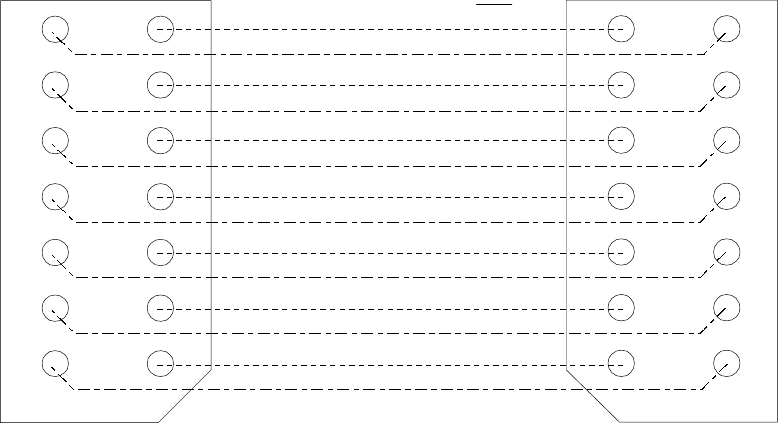
14 1
PL401 SK1
LOWBAT
SCK
SDO
RESET
BEC
7 7
TAG11336-1
38.4kHz
SDI
BEEP
PGM
ATTN
VDD
GND
B+
AREA
1
8
14
8
TLA 852/FLA 872
TM1205 Issue 2Page 5 - 10
Figure 5.4: Connections between Radio Board and Decoder Board
5.7.4 Battery-Low Circuit Test
To check the Battery-Low circuit:
a) Connect the variable DC power supply to the unit and set the output to
0.9 volts.
b) Switch ON the unit. The unit should go through the normal ‘start-up’
procedure (beep and vibrate for one second and show the programmable
switch-on message for three seconds). After approximately two minutes the
low battery symbol will appear.
c) Switch OFF the unit but do not switch OFF or disconnect the variable DC
power supply. Set the output of the variable DC power supply to 1.2 volts.
d) Switch ON the unit. Make sure that the unit goes through the normal ‘start-
up’ procedure.
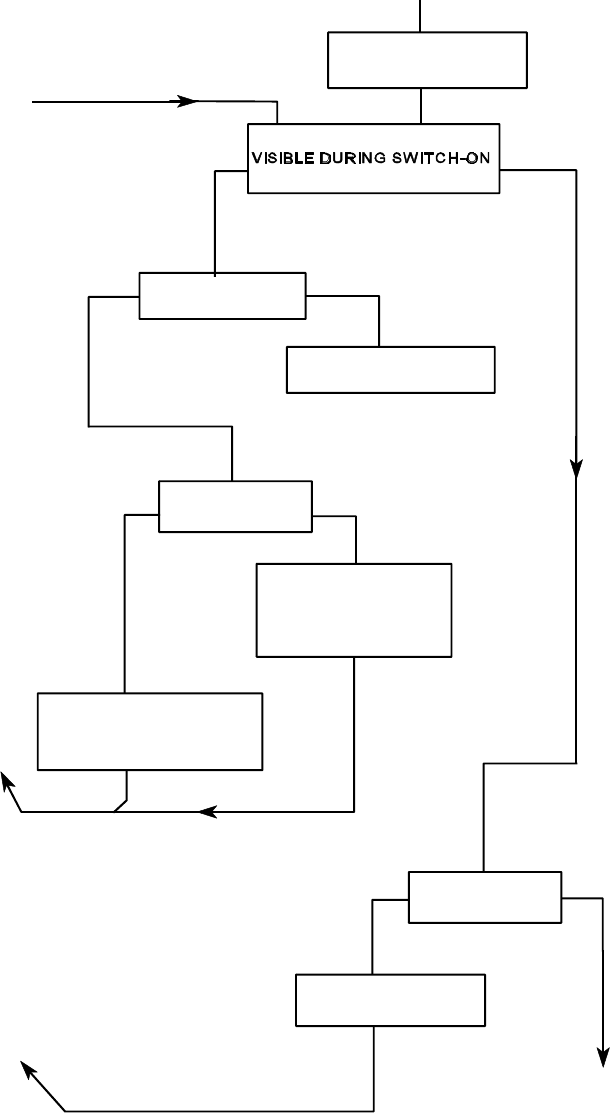
PAGER
SUSPECT
FIT A NEW BATTERY
AND SWITCH ON.
IS THE ‘SWITCH ON’ MESSAGE
IS DISPLAY BLANK
OR CORRUPTED?
CORRUPTED EEPROM.
RE-PROGRAM. RE-TEST.
CORRUPTEDBLANK
NO YES
SEQUENCE?
IS BEEP AUDIBLE
AT SWITCH-ON?
IS BEEP AUDIBLE
AT SWITCH-ON?
DE-CASE AND CHECK
DISPLAY MODULE, VDD
AND
YESNO
DE-CASE AND CHECK
SP401, TR416, TR415.
YES
NO
INTERCONNECTIONS.
DE-CASE AND CHECK
DISPLAY, VDD, IC1, IC3, IC4,
AND POWER SUPPLIES.
'A'
'A'
'B'
'A'
TAG11127-1
TLA 852/FLA 872
TM1205 Issue 2 Page 5 - 11
Figure 5.5: Fault Finding Guide (Sheet 1 of 3)
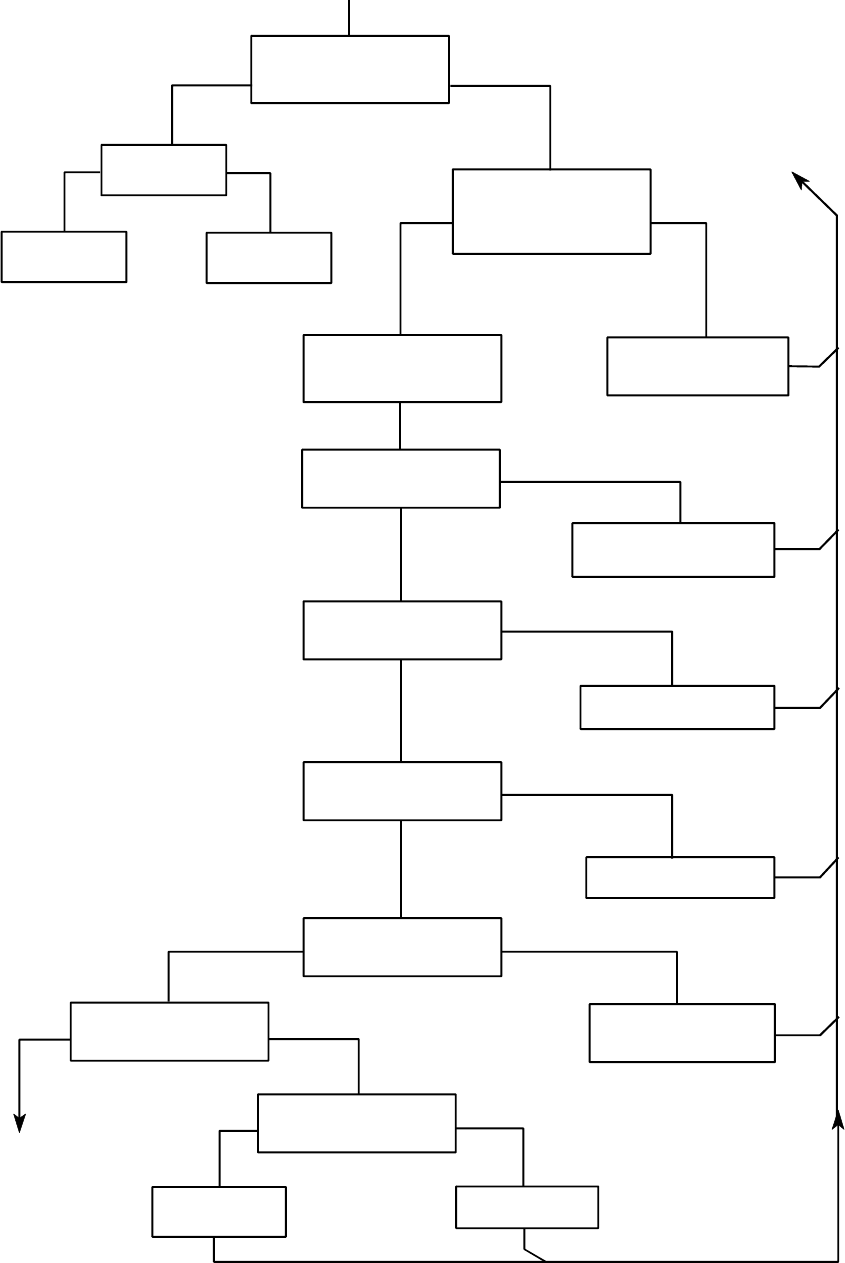
IS THE CALL RECEIVED?
CHECK
REALIGN AND
DE-CASE.
PLACE IN P671.
CHECK 1V LINE.
IS LEVEL 1V ±50mV?
CHECK TP416, TR406,
IC401.
SEND PRE-AMBLE.
AT 50dBm WITH
±4.5kHz DEVIATION.
IS DATA PRESENT ON
IC401 PIN 18?
IS DATA PRESENT ON
IC401 PIN 12?
CHECK IC402,
PINS 4, 9, 12, 13 AND 14
CHECK IC401
IS DATA PRESENT ON
IC401 PIN 11?
IS 455kHz PRESENT ON
IC401 PIN 10?
IS VOLTAGE ON
IC401 PIN 17 >1.3V?
CHECK FL404 AND
IC401 FAULTY.
CHECK IC402
AND R457.
CHECK R425, R429
IC401.
IS 455kHz PRESENT ON
IC401 PIN 6?
SENSITIVITY.
RECEIVER
RE-TEST O.K.
NO
LOW
>3dBm
O.K.
YES
NOYES
YES
NO
YES
NO
YES
NO
YESNO
YES
NO YES
NO
‘B’
‘C’
PLACE THE UNIT IN THE
P671. SEND A CALL.
TAG11134-1
‘B’
TLA 852/FLA 872
TM1205 Issue 2Page 5 - 12
Figure 5.6: Fault Finding Guide (Sheet 2 of 3)
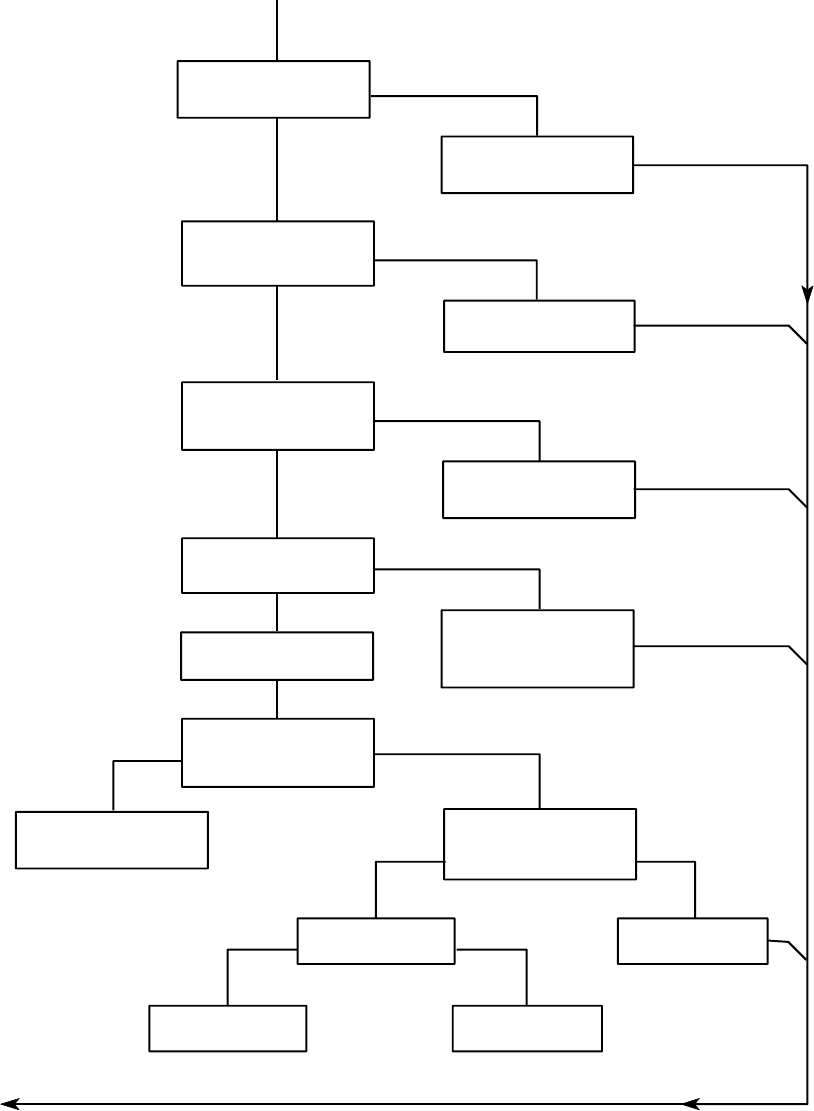
(IC401, PINS 1 AND 2)
>200mV?
REMOVE SHORT FROM
C407/R446 TO 0V.
CHECK XL401
CHECK IC401
IS TR403 (1st MIXER
O/P) >3mV?
CHECK TR410, L408
AND XL402.
CONNECT TR410 BASE
CHECK TR403
IS 455kHz PRESENT ON
TP405?
FL402 OR C444 FAULTY.
CHECK FL401, L410 AND
R444 (172MHz board).
TO 0V. IS RF LEVEL AT
NO
YES
YES
NO
YES
NO YES
YES
YES
NO
‘C’
SHORT JUNCTION OF
C407/R446 TO 0V.
IS IC401, PIN 24 >3mV?
(TR410 COLLECTOR)
>25mV?
TR403 BASE >3mV?
AND L406.
IS RF AT TR402
NO
COLLECTOR >3mV?
CHECK TR401,
TR 402, L401, L416.
YESNO
YESNO
CHECK FL405
TAG11339-1
‘B’
IS 2nd LOCAL OSC. O/P
IS 1st LOCAL OSC. O/P
R479 (280MHz board).
TLA 852/FLA 872
TM1205 Issue 2 Page 5 - 13
Figure 5.7: Fault Finding Guide (Sheet 3 of 3)
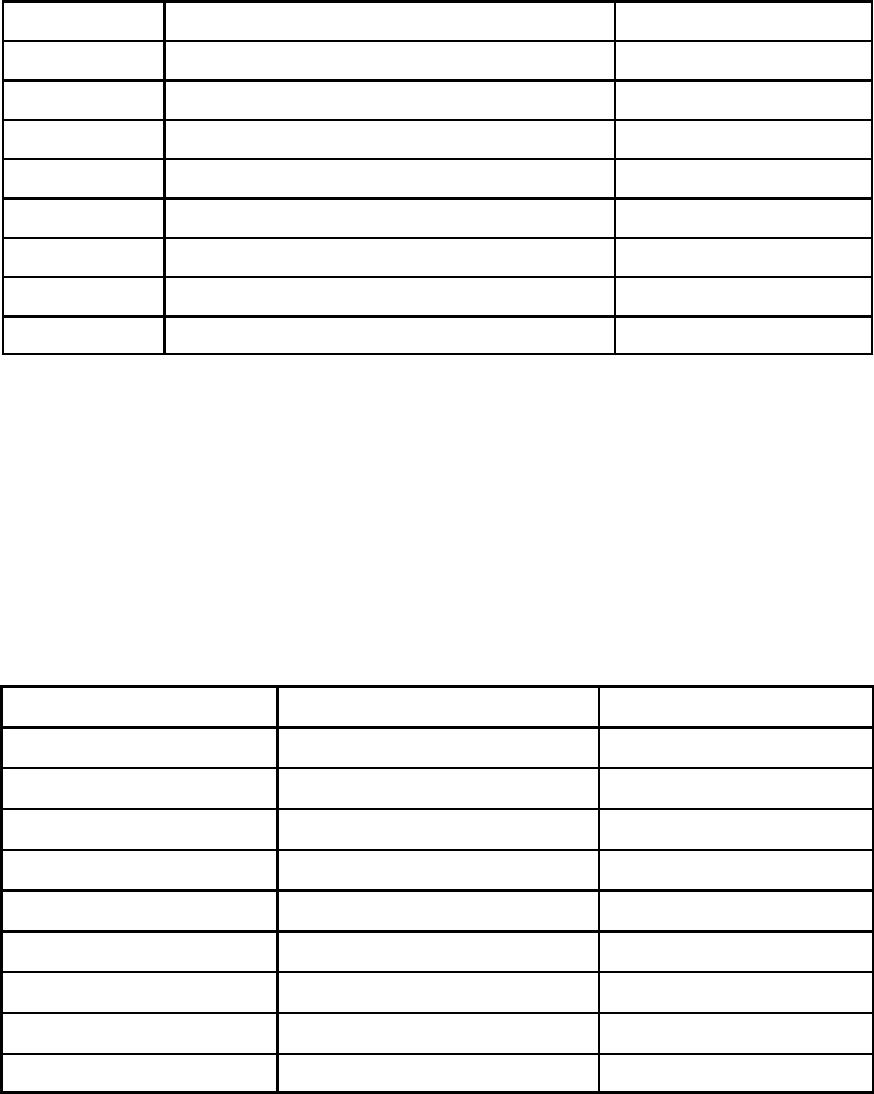
TLA 852/FLA 872
TM1205 Issue 2Page 5 - 14
COMPONENT COLLECTOR BASE EMITTER COMMENTS
TR401 0.29 0.73 0RF Amplifier
TR402 0.87 1.02 0.29 RF Amplifier
TR403 0.845 0.678 0First Mixer
TR404 0.733 0.015 0AGC Switch
TR406 1.018 0.791 1.4 1V Series Regulator
TR410 0.95 0.937 0.264 First Local Oscillator
TR415 1.4 -0Beep Enable
TR416 1.4 -0Transducer Driver
Table 5.1: Radio Board DC Voltage Levels
TEST POINT DESCRIPTION VOLTAGE / SIGNAL
401 SINAD Output 0.56Volts
402 Radio Supply 1Volt
403 RSSI (AGC) 0.060Volts
404 Radio Ground 0Volts
405 Second IF 455kHz
406 Radio Ground 0Volts
414 Radio Ground 0Volts
416 Battery + 1.4Volts
418 Radio Ground 0Volts
Table 5.2: Radio Board Test Points
NOTE: All radio board measurements were taken with the receiver turned on. The battery
terminal voltage was 1.4 volts, the 1 volt line was 1.019 volts and battery economy was
disabled. Voltages may vary by ±20mV.
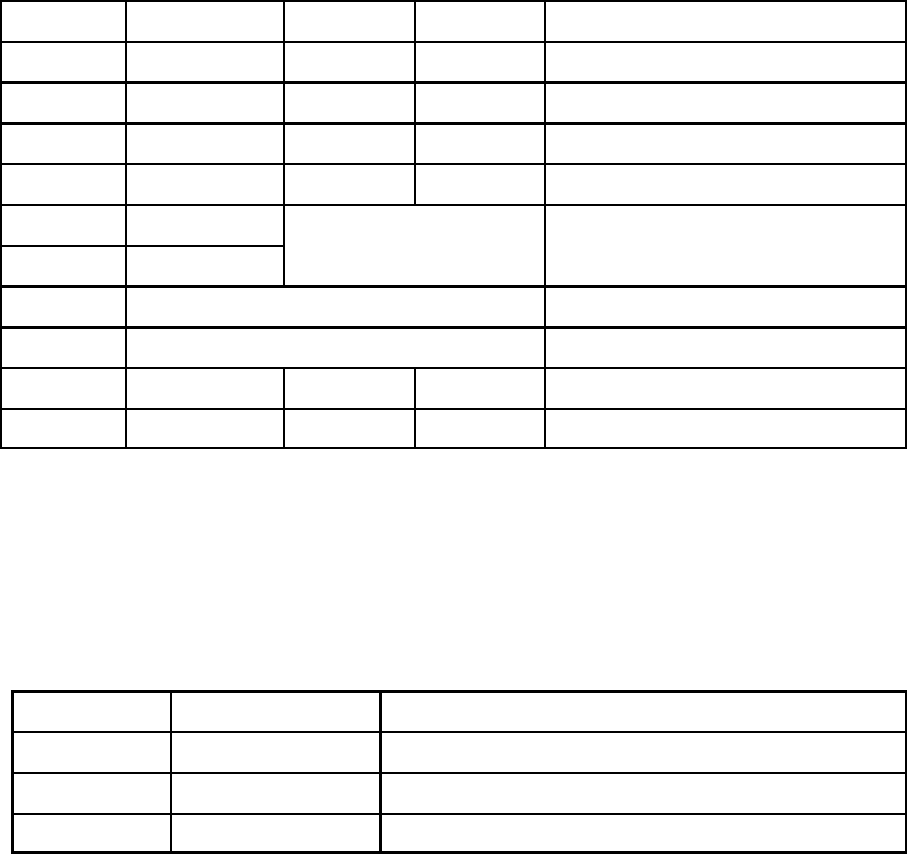
TLA 852/FLA 872
TM1205 Issue 2 Page 5 - 15
DEVICE COLLECTOR BASE EMITTER REMARKS
TR1 3.00 3.00 1.4 Battery Disconnect Monitor
TR2 -3.00 1.4 Backlight Driver
TR3 1.4 - - Vibrate Enable
TR4 1.4 - - Vibrate Motor Drive
C5 0.19dc 2.2 V p-p 4ms wide XL2 4.19MHz
R1/C4 3.00
R35 1.49dc 3.0V p-p CLKO 38.4kHz
IC402 pin9 1.49dc 3.0V p-p XL403 38.4kHz (Radio Board)
IC5 3.00 (pin 1) 3.00 (pin 2) 0 (pin 3) Reset
IC6 1.4 (pin 1) 3.00 (pin 2) 1.4 (pin 5) VDD Supply
Table 5.3: Decoder Board DC Levels
STEP TEST POINT REMARKS
1R23 VDD
2R35 38.4kHz POCSAG Clock
3R1 4.19MHz Microprocessor Clock (every 500ms)
Table 5.4: Decoder Board Test Sequence

VOLTS
TIME
2.2V
0.19V
4.19MHz WITHIN THE ENVELOPE
4ms
WAVEFORM AT R1/C4
VOLTS
TIME
4ms
TAG11333-1
WAVEFORM AT C5
0V
3V
VOLTS
0V
1.49V
3V p-p 38kHz
WAVEFORM AT R1/C4
WAVEFORM AT R35 AND IC402, PIN9
TIME
TLA 852/FLA 872
TM1205 Issue 2Page 5 - 16
Figure 5.8: Decoder Board Waveforms
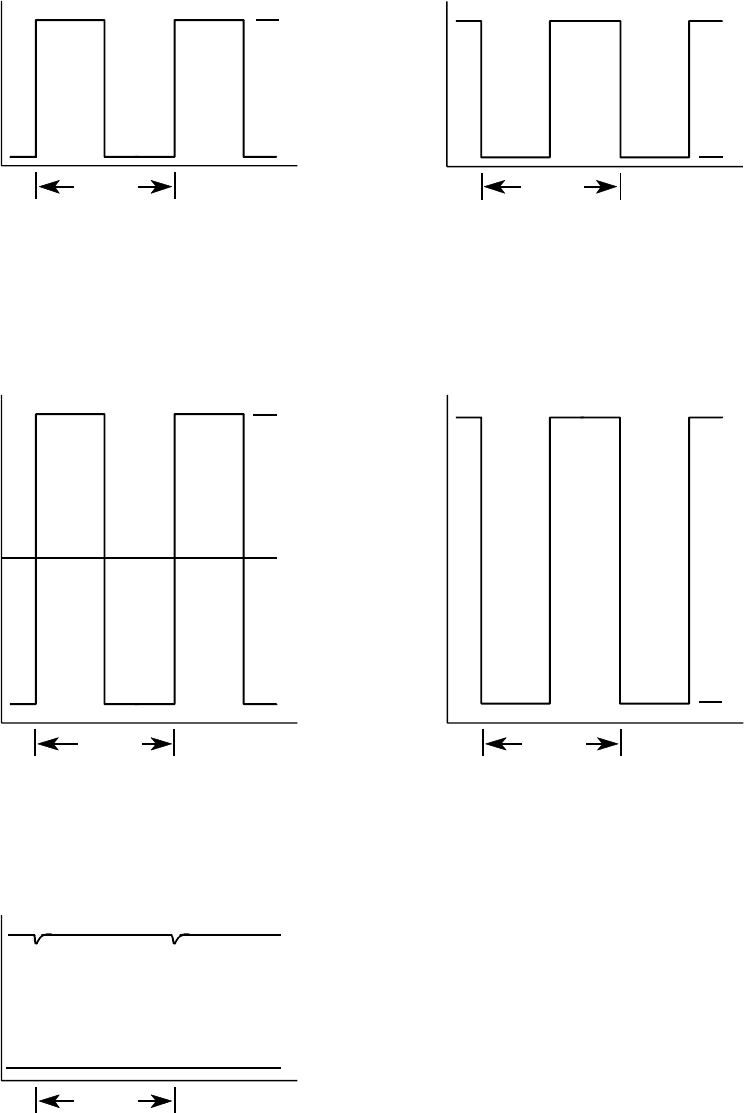
1.6ms TIME
0V
WAVEFORM AT PIN 39
3V p-p
VOLTS
1.6ms TIME
0V
WAVEFORM AT PIN 45
3V
VOLTS
1.6ms TIME
WAVEFORM AT PIN 40
0V
6V p-p
VOLTS
TIME
1.6ms
WAVEFORM AT PIN 41
0V
6V p-p
VOLTS
1.6ms TIME
0V
WAVEFORM AT PIN 38
3V p-p
VOLTS
TAG11132-1
TLA 852/FLA 872
TM1205 Issue 2 Page 5 - 17
Figure 5.9: Display Module Waveforms
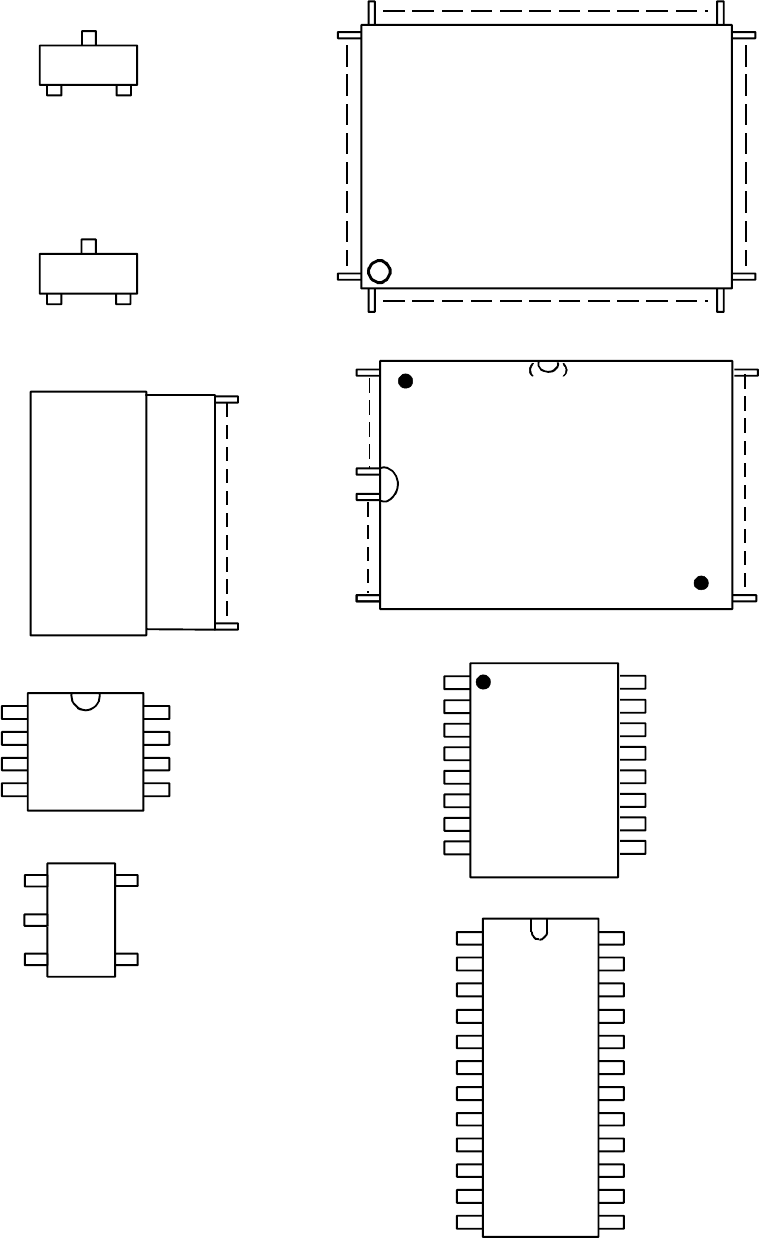
C
BE
TR2, 4
1
12 13
24
IF IN
OSC BASE
IF DE-COUPLE
QUAD IN
RF IN
GROUND
REG IN
BATTERY ALARM
FSK OUT
POWER SAVE
SHAPING CAP
PRI SHAPING CAP
QUICK CHARGE
FILTER OUT
DET OUT
FILTER IN
OSC EMITT
IF DE-COUPLE
IF OUT
IC401
TAG11264-1
1
4 5
8
VCC
TEST
SDA
A2 IC1
VSS
A0
EXCEPT FOR THE LCD MODULE,
ALL DEVICES ARE VIEWED FROM ABOVE.
IC3
7
49
64
48
17
16
µP
32
33
1 16
IC402
IC4
1
3
NCOUT 5
4
IC5
MIXER OUT
Vcc REG OUT
RSSI OUT
RSSI IN
9
8
BS1
BS2
BS3
SIGNAL
XVSS
XT
XTN
VSS
VDD
ATTN
SDI
SDO
SCK
AREA
RSTN
CLKO
1
28
8
1
22 21
Module)
(Rear of
A1
SCL
Vdd
NC
Vss
51
1
LCM
407, 410, 414
TR401, 402, 403, 406
3 (C)
1 (B) 2 (E)
TR1, 3, 415
NOT TO SCALE.
SONY
(NEC CONFIGURATION )
(1)
(14) (15)
(28)
( )
( )
(IS SHOWN IN PARENTHESIS)
IC6
TLA 852/FLA 872
TM1205 Issue 2Page 5 - 18
Figure 5.10: Semiconductor Connection Details
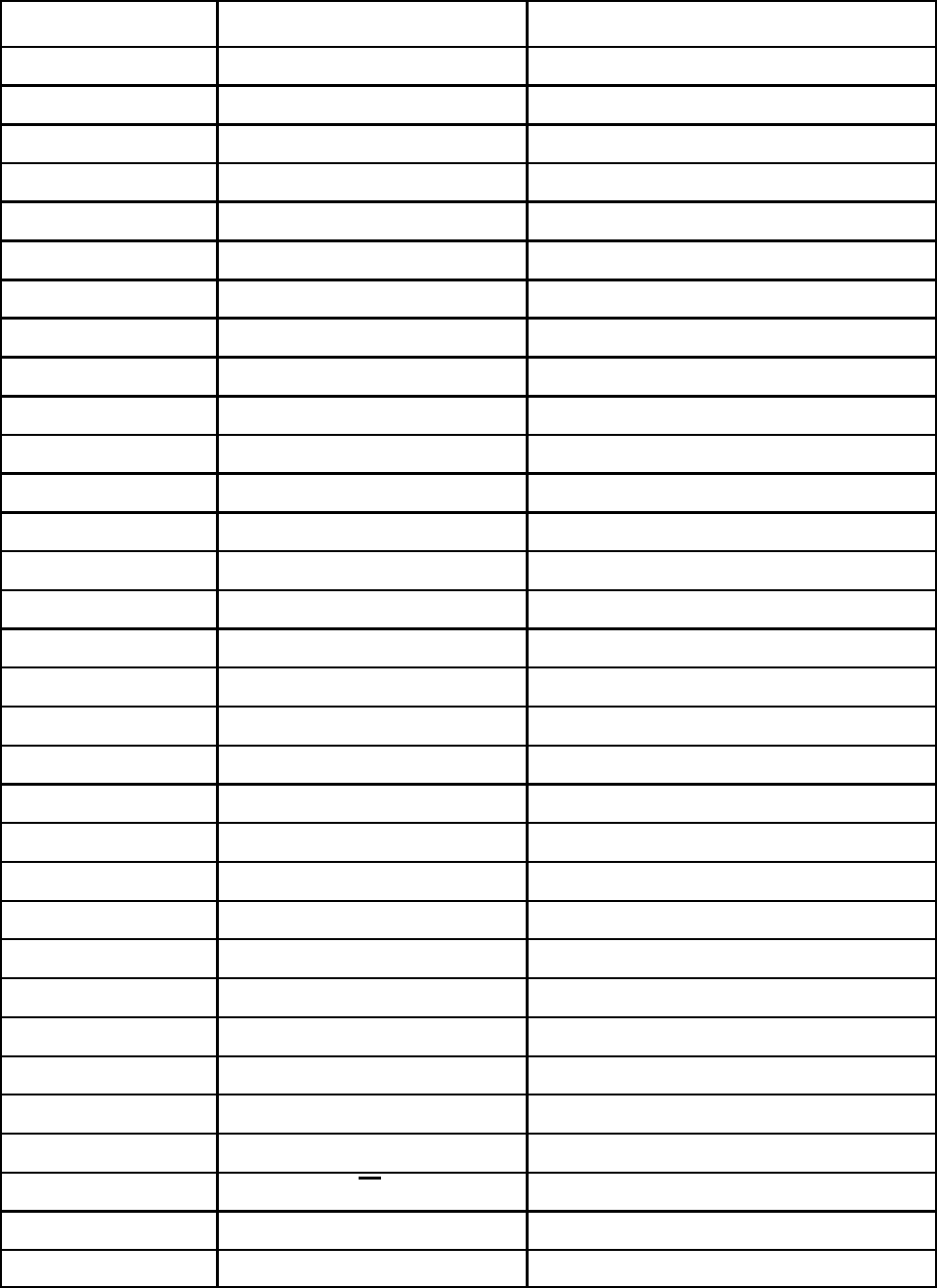
TLA 852/FLA 872
TM1205 Issue 2 Page 5 - 19
Pin Number Pin Name Description
1P30 PGM - programming input
2P31 BEEP - output signal
3P32 ROM-CE - CGROM (IC2) chip enable
4P33 RAM-CE - SRAM (IC4) chip enable
5P34 LCD-CS - Display chip select
6P35 µP (IC3) low current mode switch
7P36 Vibrate Motor - output signal
8P37 Lamp - output signal
9VSS Ground
10-12 P40-P42 SW1-SW3 - input signal
13,14,16,17 NC Not Used
15 P45 µP (IC3) low current mode switch
18-23,25-34,38,39 P50-P57,P60-P67,P02,P03 Address lines AD00-AD17
24 VSS Ground
35 RESET µP reset - input signal
36 P00 AREA (No valid data) - input signal
37 P01 ATTN (Valid data) - input signal
40 VDD VDD
41 X2 Xtal oscillator
42 X1 Xtal oscillator
43,46 VPP/IC,AVSS Ground
44 NC Not Used
45 P04/XT1 POCSAG clock - input signal
47-54 D00-D07 Data lines
55 AVDD VDD
56 AVR Ground
57 P20 SDO - Data input signal
58 P21 SDI - µP info. to POCSAG decoder
59 P22 SCK - Data transfer clock
60 WR Display and RAM - Read/write control
61 P24 LOWBAT - output signal
62,63,64 P25,P26,P27 Serial Data input from EEPROM (IC1)
Table 5.5: IC3 Microprocessor Pin Connections

TLA 852/FLA 872
TM1205 Issue 2Page 5 - 20
Pin Number Pin Name Description
1A14 Address line AD14
2A12 Address line AD12
3A7 Address line AD07
4A6 Address line AD06
5A5 Address line AD05
6A4 Address line AD04
7A3 Address line AD03
8A2 Address line AD02
9A1 Address line AD01
10 A0 Address line AD00
11 D0 Data line D00
12 D1 Data line D01
13 D2 Data line D02
14 VSS Ground
15 D3 Data line D03
16 D4 Data line D04
17 D5 Data line D05
18 D6 Data line D06
19 D7 Data line D07
20 CE RAM-CE - chip enable input
21 A10 Address line AD10
22 OE Ground
23 A11 Address line AD11
24 A9 Address line AD09
25 A8 Address line AD08
26 A13 Address line AD13
27 WE WR - RAM read/write control
28 VDD VDD
Table 5.6: IC4 RAM Pin Connections
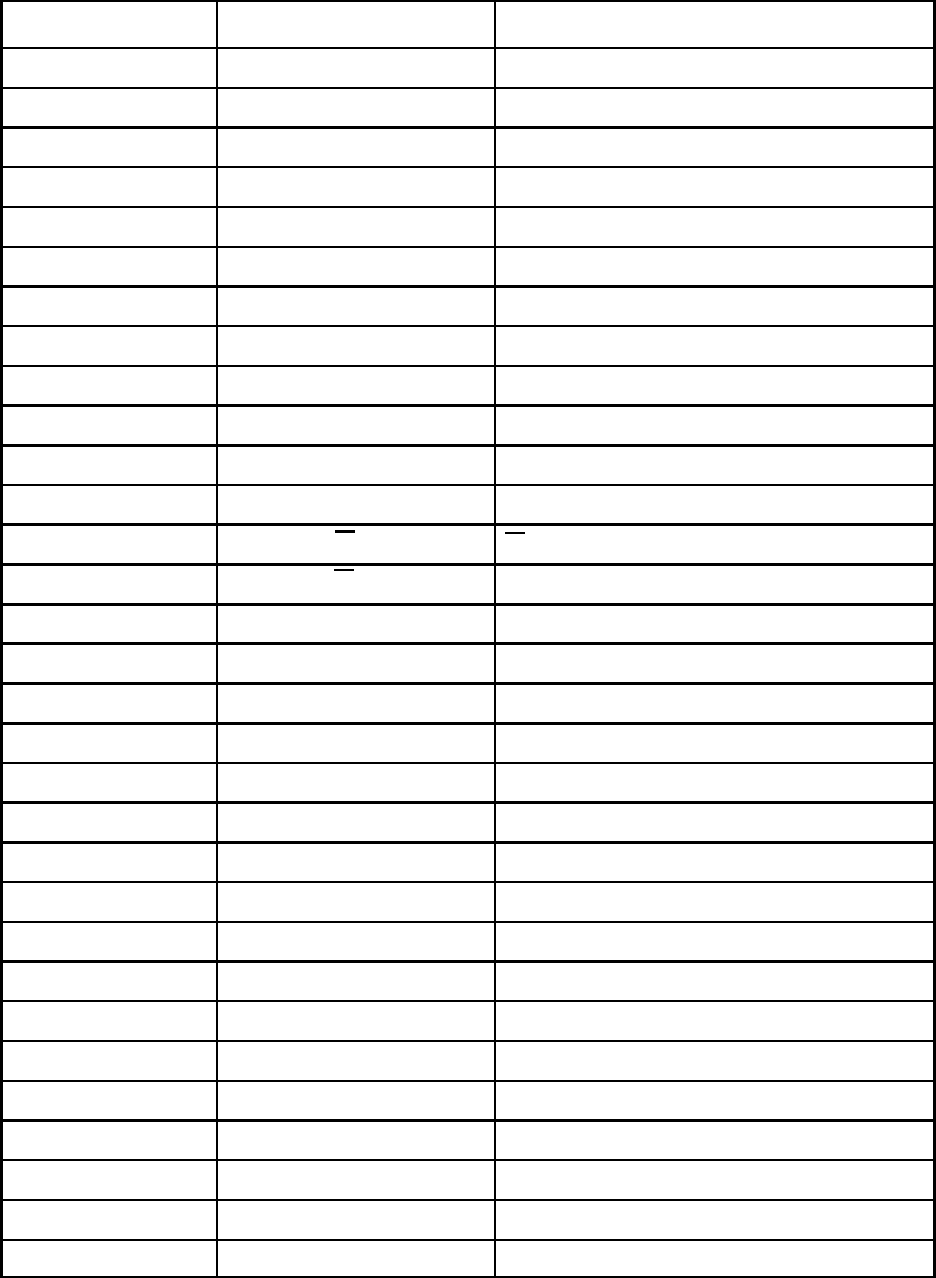
TLA 852/FLA 872
TM1205 Issue 2 Page 5 - 21
Pin Number Pin Name Description
1 NC Not Connected
2-6 V5-V1 LCD driver supply voltages
7 VDD VDD
8 M/S VDD
9 RESET Reset - input signal
10 SCL VDD
11 SI VDD
12 P/S VDD
13 CS1 LCD-CS - chip select
14 CS2 VDD
15 C86 Ground
16 A0 AD16 - display address input signal
17 WR WR - LCD write enable input signal
18 RD AD17 - read enable input signal
19 VSS Ground
20-27 D0-D7 D00-D07 - Data lines
28-31 DYO, CLO, SYN, FR Not Used
32 CL Ground
33 OSC1 LCD Oscillator
34 OSC2 LCD Oscillator
35-37 T2, T1, VSS Ground
38 CAP1+ DC/DC voltage converter capacitor 1
39 CAP1- DC/DC voltage converter capacitor 1
40 CAP2+ DC/DC voltage converter capacitor 2
41 CAP2- DC/DC voltage converter capacitor 2
42 VOUT DC/DC voltage converter output
43 V5 LCD driver supply voltage
44 VR Voltage adjustment terminal
45 VDD VDD
46-50 V1-V5 LCD driver supply voltages
51 NC Not Connected
Table 5.7: LCD Display Pin Connections
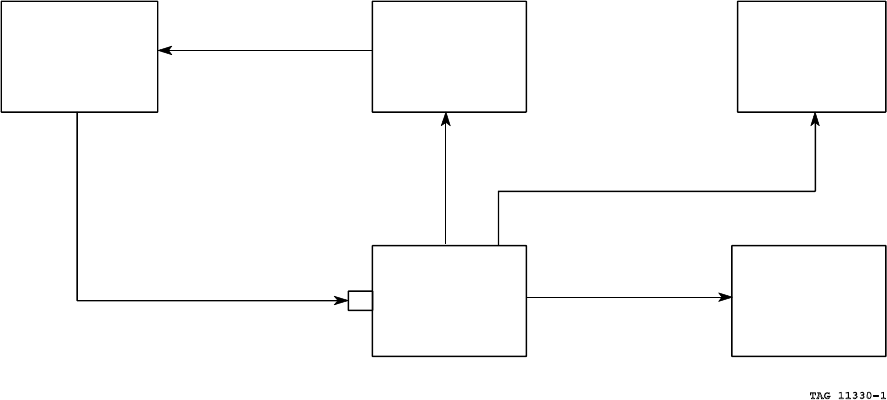
SIGNAL COUNTER
HF
GENERATOR
SINAD
P671A OSCILLO-
SCOPE
METER
AUDIO OUT
1kHz MODULATION
INPUT
455kHz
RF IN
10dB
ATTENUATOR
TLA 852/FLA 872
TM1205 Issue 2Page 5 - 22
Figure 5.11: Radio Alignment Test Equipment
5.8 RADIO ALIGNMENT PROCEDURE
5.8.1 Preparation
a) Remove the Board Assembly from the Case (see paragraph 5.5.2).
b) Install a 0 ohm resistor or a shorting link in the position for R456, to disable
the BEC.
c) Disable the AGC circuit by connecting TP403 to 0 volts. Alternatively, lift
R409.
5.8.2 Alignment Procedure
a) Configure the test equipment as shown in Figure 5.11. Set the signal
generator to the channel frequency with an output of -10dBm.
b) Put the Board Assembly in the tray of the P671A Alignment Jig and connect
the frequency counter probe to TP405. Adjust CV405 to give a reading of
455kHz ±50Hz at the frequency counter.
c) Adjust CV406 for maximum amplitude of the 455kHz signal on the
oscilloscope. A minimum of 500 millivolts should be achieved.
d) Remove the AGC disable and assemble the Board Assembly in the case.
Remove the right hand label from the case back to expose the aerial trimmer.
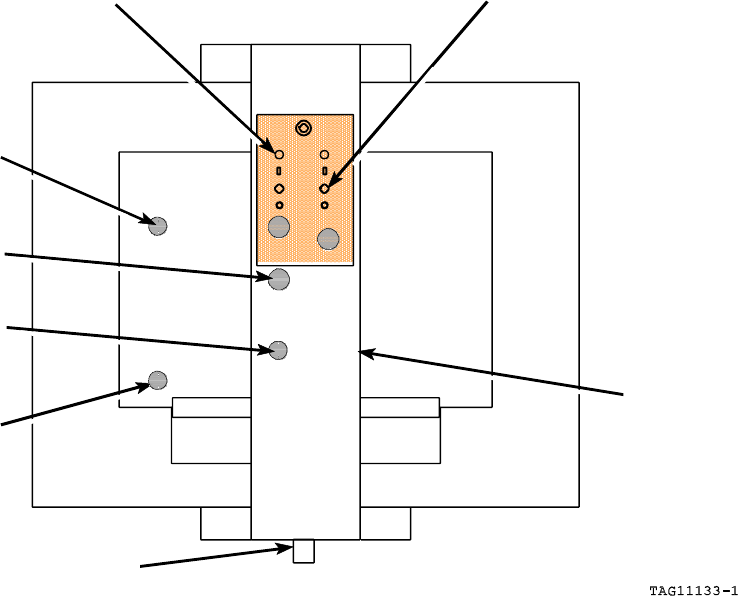
ARM
ARM LOCK
CV404
CV406
CV407
ALIGNMENT PINS PROGRAMMING PINS
CV405
TLA 852/FLA 872
TM1205 Issue 2 Page 5 - 23
Figure 5.12: P671A Showing the Tuning Points
e) Put a known good battery in the unit (but leave the battery door off). Put the
unit in the P671A jig, fold the jig arm over the unit and lock the arm in
position.
f) Connect the SINAD meter to the alignment pins on the P671A (refer to
Figure 5.12)
g) Set the modulation of 1kHz to a deviation of 3 kHz and switch it ON. Adjust
CV404 to give 12dB sinad with minimum RF input. A reading of -98dB
should be achieved.
NOTE: Do not disturb the aerial during the next operation.
h) Carefully remove the Board Assembly from the case. Remove the BEC
disable 0 ohm resistor or the shorting link from R456 position. Carefully
assemble the Board Assembly in the case and put a new label on the case
back to cover the aerial trimmer access hole.
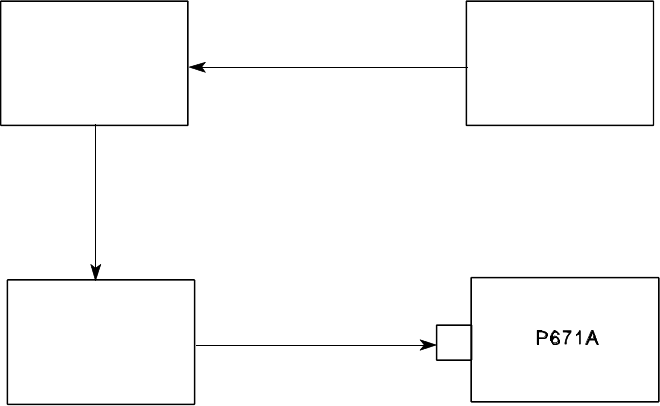
GENERATOR
SIGNAL
PC
RF IN
10dB
ATTENUATOR
P645
TAG11331-1
DATA
NOTE: THE DISTANCE BETWEEN THE
PC AND THE P671A MUST BE
GREATER THAN TWO METRES
TLA 852/FLA 872
TM1205 Issue 2Page 5 - 24
Figure 5.13: Configuration for Coarse Sensitivity Measurement
5.8.3 Pager Sensitivity Measurement (Coarse)
To determine the pager sensitivity, configure the test equipment as shown in
Figure 5.13 and do the procedure given in sub-paragraphs a) through e).
NOTE: This is only an indication of sensitivity,which is dependent on the unit
under test being in a noise free environment.
a) Set the signal generator to the channel frequency, at a deviation of 4.5kHz
and an output level of -85dBm.
b) Install a known good battery in the pager and switch it ON.
c) Put the pager in the P671A and send a sensitivity call from the P645.
Increase the signal generator output level, if necessary, to obtain a correctly
received call.
d) Reduce the RF level in 1dB steps until the pager receives less than three
calls in five.
e) Increase the RF level in 1dB steps until five consecutive calls are received.
An output level of -98dBm should be acheived.
5.8.4 Pager Sensitivity Measurement (Fine)
Configure the equipment as described in paragraph 5.8.3 but connect a P800 TEM
cell instead of the P671A. Follow the steps given in the TEM Cell Instructions for
the IEC method. Place the pager in the polystyrene block (refer to Figure 5.14)
positioned centrally in the TEM Cell, with the display facing the input end. A level
of -103dBm or better should be achieved.
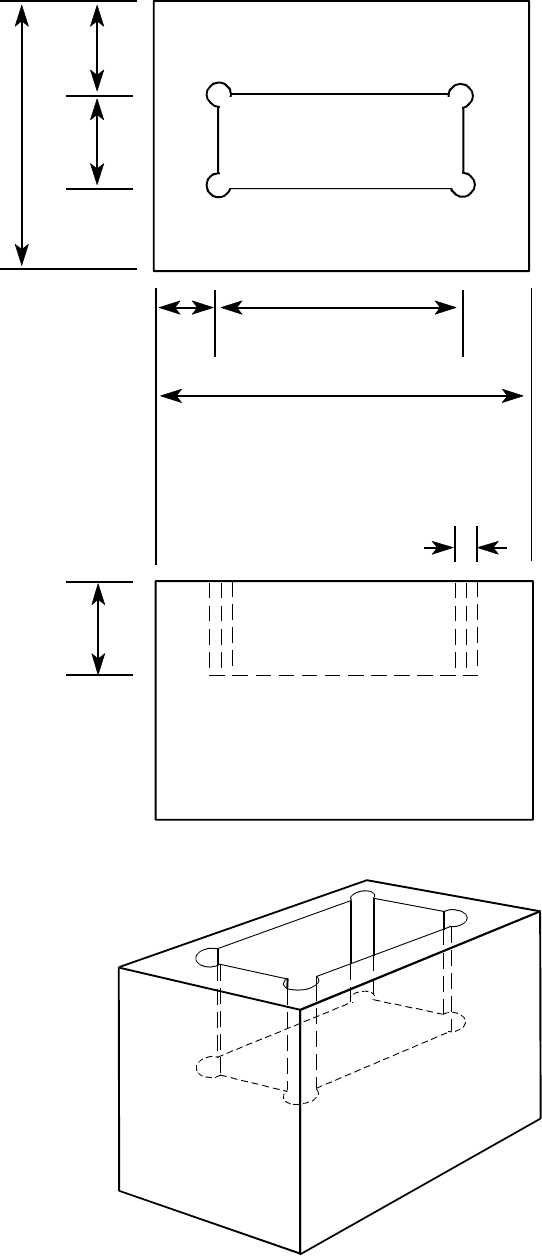
TAG11124-1
+
++
60mm
14mm 52mm
20mm
20mm
+
20mm
ø 5mm
80mm
TLA 852/FLA 872
TM1205 Issue 2 Page 5 - 25
Figure 5.14: Polystyrene Block for TEM Cell Test - Dimensions
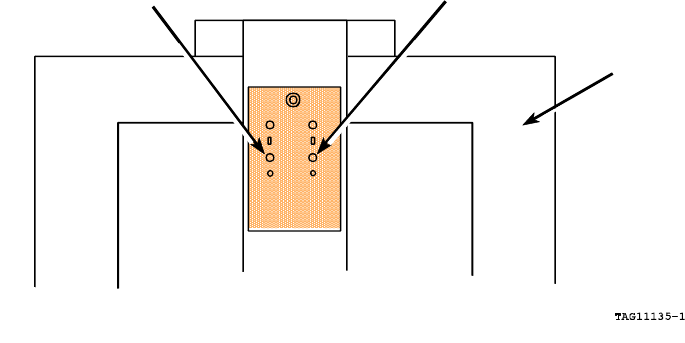
CONNECT THE BLUE
WIRE TO THIS PIN
CONNECT THE BROWN WIRE TO THIS PIN
P671A
TLA 852/FLA 872
TM1205 Issue 2Page 5 - 26
Figure 5.15: Programming Lead Connections
5.9 PROGRAMMING
5.9.1 General
The pager contains an EEPROM which holds unique data. The data may be
altered as shown in the following paragraphs.
5.9.2 Equipment
The following equipment is required:
!P671A Alignment Jig
!P669H Programming Software
!Programming Cable
!IBM PC or equivalent
5.9.3 Procedure
Program the receiver as follows:
a) Remove the Battery Door from the Case Back.
b) Put the unit face down in the tray of the P671A, lower the arm over the unit
and lock the arm in position.
c) Use the Progamming Cable to connect the programming pins of the P671A
to the PC serial port. Refer to Figure 5.15 and connect the correct coloured
wire to each programming pin.
d) Read the ‘Readme’ file contained in the relevant programming software. The
‘readme’ file describes how to use the programming facility.

TLA 852/FLA 872
TM1205 Issue 2 Page 6 - 1
SECTION 6
SPARE PARTS LIST
CONTENTS: Page
6.1 ASSEMBLIES 6 - 1
6.1.1 Modules 6 - 1
6.1.2 Case Parts 6 - 1
6.1.3 Batteries 6 - 2
6.1.4 Battery Packs 6 - 2
6.2 RADIO BOARD COMPONENTS 6 - 3
6.2.1 Capacitors 6 - 3
6.2.2 Banded Capacitors 6 - 3
6.2.3 Crystal and Filters 6 - 4
6.2.4 Inductors 6 - 4
6.2.5 Resistors 6 - 4
6.2.6 Semiconductors 6 - 5
6.2.7 Miscellaneous 6 - 5
6.3 DECODER BOARD COMPONENTS 6 - 6
6.3.1 Capacitors 6 - 6
6.3.2 Resistors 6 - 6
6.3.3 Semiconductors 6 - 6
6.3.4 Miscellaneous 6 - 7
CAUTION
STATIC SENSITIVE DEVICES ARE USED IN THIS EQUIPMENT. CARE MUST BE TAKEN
WHEN HANDLING THESE DEVICES AS THEY MAY BE DAMAGED BY HIGH LEVELS OF
STATIC ELECTRICITY.
TLA 852/FLA 872
TM1205 Issue 2Page 6 - 2
ITEM/CIRCUIT
REFERENCE DESCRIPTION PART No.
6.1 FREQUENCY BAND INFORMATION
BAND 1 138.000 -143.499 MHZ
BAND 2 143.500 -148.999 MHZ
BAND 3 149.000 -154.999 MHZ
BAND 4 155.000 -160.999 MHZ
BAND 5 161.000 -167.499 MHZ
BAND 6 167.500 -174.100 MHz
6.2 ASSEMBLIES
6.2.1 Modules
DECODER ASSEMBLY 0201-0954
6.2.2 Case Parts and Battery
CASE FRONT, RESTYLE, BLACK 0301-0911
CASE FRONT, BLACK 0301-0922
CASE FRONT, SOFT BLACK 0801-0303
CASE FRONT, RESTYLE, BLUE 0301-0906
CASE FRONT, BLUE 0301-0917
CASE FRONT, SOFT BURG99 0801-0302
CASE FRONT, GREY, OMPT 0301-0923
WINDOW, MULTITONE, NEW LOGO 0961-5986
WINDOW, MULTITONE 0961-5014
WINDOW, VODAFONE 0961-5962
WINDOW, ZAP! 0961-5828
WINDOW, FLAIR 0961-5639
WINDOW, OMPT MOROCCO 0961-5529
WINDOW, SYSTEL 0961-5764
WINDOW, ENERGONET, TLA 852 0961-5611
WINDOW, ENERGONET, FLA 872 0961-5794
CASE BACK MOULDING, BLACK 0801-0150
CASE BACK MOULDING, BLUE 0801-0145
BATTERY DOOR MOULDING, BLACK 0801-0160
BATTERY DOOR MOULDING, BLUE 0801-0155
BUTTON TLA STYLE 2 BLK CHEV 0801-0186
HOLSTER, BLACK 0801-0277
HOLSTER, BLACK, VODAFONE 0801-0345
BATTERY ALKALINE "AAA" 5601-0006
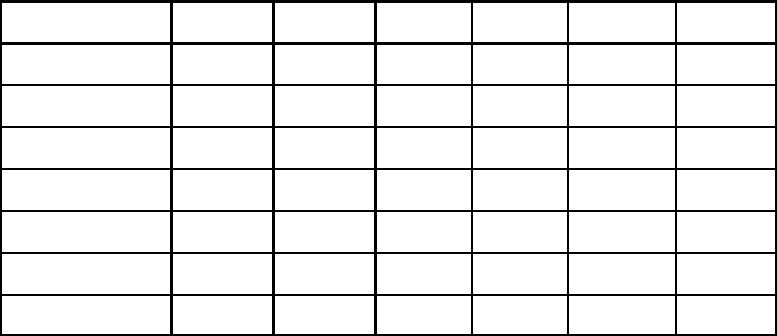
TLA 852/FLA 872
TM1205 Issue 2 Page 6 - 3
CCT REF Band 1 Band 2 Band 3 Band 4 Band 5 Band 6
C401,445 100p 100p 100p 100p 100p 100p
C405, 455, 466 12p 12p 10p 10p 6p8 6p8
C409 LINK LINK LINK LINK LINK LINK
C432 3p9 3p9 3p9 3p9 3p9 3p9
C446 1p 1p 1p 1p 1p 1p
C465 4p7 4p7 4p7 4p7 4p7 4p7
C467 18p 15p 12p 10p 8p2 6p8
ITEM/CIRCUIT
REFERENCE DESCRIPTION PART No.
6.2.3 Miscellaneous
BATTERY CONTACT +VE 7361-4862
BATTERY CONTACT -VE SPRING 7361-4861
LANYARD (ELASTICATED) 7961-5055
GASKET, DISPLAY SEAL 2561-5007
SPACER MOULDING RUBBER VHF 0861-5209
SCREW 2.2mm x 6mm PAN HEAD, S/TAP 8216-2296
6.3 RADIO BOARD COMPONENTS
6.3.1 Capacitors
C403,410,412,414,472,473,484 CHIP 10n ±10% 50V 3327-0025
C404,406,453,481 CHIP 220p ±5% 50V 3326-0031
C407 CHIP 27p ±5% 50V 3326-0020
C408,485,495 CHIP 22p ±5% 50V 3326-0019
C418,423,425,444,450,452,469, CHIP 100n ±10% 16V 3332-0014
C471,474,479,480 CHIP 100n ±10% 16V 3332-0014
C426 CHIP 33p ±5% 50V 3326-0021
C436,493,494,496 CHIP 22µ ±20% 4V 3412-0005
C448 CHIP 3n3 ±10% 50V 3327-0019
C449 CHIP 22n +80-20% 50V 3328-0009
C470 CHIP 1µ -20/+80% 16V 3301-0277
C483 CHIP 560p 3326-0036
C486 CHIP 68n 3332-0012
C490 CHIP 47µ ±20% 6.3V 3412-0110
C492 CHIP 4.7µ 6.3V 3412-0104
CV404,405,406,407 TRIMMER 10p, REAR ADJUSTMENT 3502-0018
6.3.2 Banded Capacitors

TLA 852/FLA 872
TM1205 Issue 2Page 6 - 4
CCT REF Band 1 Band 2 Band 3 Band 4 Band 5 Band 6
L401 82n 82n 68n 68n 68n 56n
L406, 410 2µ2 2µ2 2µ2 2µ2 2µ2 2µ2
L407 100n 100n 100n 100n 100n 100n
L408 330n 330n 270n 270n 270n 270n
L409 560n 560n 470n 470n 390n 390n
L416 68n 68n 56n 56n 47n 47n
L417 47n 47n 39n 39n 33n 33n
L418 N/F N/F N/F N/F N/F N/F
DESCRIPTION PART No. DESCRIPTION PART No.
1p ±0.25% 50V 3326-0015 12p ±5% 50V 3326-0016
3p9 ±0.25p 50V 3326-0010 15p ±0p5 50V 3326-0017
4p7 ± 0p25 50V 3326-0011 18p ±0p5 50V 3326-0018
6p8 50V 3326-0013 100p ±5% 50V 3326-0027
8p2 50V 3326-0014
10p ±0p5 50V 3326-0015 LINK (RES CHIP 0S)3115-0001
ITEM/CIRCUIT
REFERENCE DESCRIPTION PART No.
6.3.3 Crystal and Filters
FL401 CRYSTAL FILTER 21.4MHz 4001-0025
FL402, 403 CERAMIC FILTER, SMD, 10/12.5kHz 4018-0004
FL402, 403 CERAMIC FILTER, SMD, 20/25kHz 4018-0002
FL404 FILTER CHIP CDBC455CX25-TC 4003-0005
XL401 CRYSTAL 20.945MHz 3915-0017
XL402 CRYSTAL, GENERIC SPEC 3948-*
XL402 CRYSTAL, GENERIC SPEC 3950-*
XL403 MICRO CRYSTAL MX1V-TL 76.8 kHz 3922-0012
* QUOTE CHANNEL FREQUENCY TO SIX DECIMAL PLACES
6.3.4 Inductors
DESCRIPTION PART No. 68n ±10% 4117-0020
2µ2 ±10% 4103-0233 82n ±10% 4117-0021
39n ±10% 4117-0017
47n ±10% 4117-0018
56n ±10% 4117-0019
TLA 852/FLA 872
TM1205 Issue 2 Page 6 - 5
DESCRIPTION PART No.
100n ±5% 4103-0254
270n ±5% 4103-0264
330n ±5% 4103-0266
390n ±5% 4103-0268
470n ±5% 4103-0270
560n ±5% 4103-0272
ITEM/CIRCUIT
REFERENCE DESCRIPTION PART No.
6.3.5 Resistors
R5, 8, 472-478 CHIP 0S 62m5W 3115-0001
R401,403,439,470 CHIP 100S ±5% 62m5W 3115-0050
R402,405 CHIP 18k ±5% 62m5w 3115-0104
R404,438 CHIP 680S ±5% 62m5W 3115-0070
R406 CHIP 1k ±5% 62m5W 3115-0074
R408 CHIP 330S ±5% 62m5W 3115-0062
R410 CHIP 33S ±5% 62m5W 3115-0110
R412 CHIP 3k3 ±5% 62m5w 3115-0086
R416 CHIP 82k, 10/12.5kHz 3115-0120
R416 CHIP 39k ±5% 62m5, 20/25kHz 3115-0112
R420,455,457,471 CHIP 100k ±5% 62m5W 3115-0122
R425, 428, 429 CHIP 180k ±5% (512 BAUD) 3115-0128
R425, 428, 429 CHIP 82k (1200 BAUD) 3115-0120
R425, 428, 429 CHIP 39k ±5% (2400 BAUD) 3115-0112
R434,446 CHIP 15k ±5% 62m5W 3115-0102
R440 CHIP 220S ±5% 62m5W 3115-0058
R443 CHIP 5k6 ±5% 62m5W 3115-0092
R444 CHIP 2K7 ±5% 62m5W 3115-0084
R458,459 CHIP 10S ±5% 62m5W 3115-0026
6.3.6 Semiconductors
IC401 IC TK14590V 3825-0002
IC402 IC POCSAG DECODER 3820-0025
TR401,402,403,410 TRANSISTOR NE85619 3601-0013
TR406 TRANS PNP. BC808-40W 3602-0058
TR415 TRANS RN1305 3611-0002
TR416 TRANS 2SD1757KS 3602-0038
6.3.7 Miscellaneous
AE401 AERIAL, TOP, VHF 5561-5254
AE402 AERIAL, BOTTOM, VHF 5561-5255
PL401 HEADER 14-WAY 4332-0002
SP401 TRANSDUCER 5004-0007
TLA 852/FLA 872
TM1205 Issue 2Page 6 - 6
ITEM/CIRCUIT
REFERENCE DESCRIPTION PART No.
6.4 DECODER BOARD COMPONENTS
6.4.1 Capacitors
C3,6,8,10,14,19,20-25 CHIP 100n ±10% 16V 3332-0014
C4,5 CHIP 27p ±5% 50v 3326-0020
C9,11 CHIP 1n ±10% 50V 3327-0013
C12,15 CHIP 47µ ±20% 6V3 3412-0110
C13 CHIP 100p ±5% 50v 3326-0027
C17,18,26 CHIP 1µ -20/+80% 16V 3301-0277
C 28 (FLA) CHIP 100n ±10% 16V 3332-0014
C 29 (FLA) CHIP 180p ±5% 50V 3326-0030
6.4.2 Resistors
R1 CHIP 1k5 ±5% 62m5W 3115-0078
R2-5,18,19,29 CHIP 100k ±5% 62m5W 3115-0122
R6,7,17,26,27,30,
31,34-36 CHIP 10k ±5% 62m5W 3115-0098
R8 CHIP 47S ±5% 62m5W 3115-0042
R9 CHIP 1k ±5% 62m5W 3115-0074
R10 CHIP 18k ±5% 62m5w 3115-0104
R11,21,22 CHIP 470k ±2% 62m5W 3118-0138
R12,20 CHIP 150k ±2% 3118-0126
R13 CHIP 680k ±2% 3118-0142
R14,28 CHIP 1M ±2% 0603 3118-0146
R15,16 CHIP 220S ±5% 62m5W 3115-0058
R23,24,25,99,103 CHIP 100S ±5% 62m5W 3115-0050
6.4.3 Semiconductors
D1 DIODE, CHIP BAT 74 3710-0002
D4 DIODE RB715F 3710-0005
D2 (FLA) DIODE, CHIP BAV 99 3703-0001
IC1 IC 512X8 EEPROM 3818-0006
IC2 (FLA) IC SP4425 EL LAMP DRIVER 3818-0027
IC4 IC 32KX8 SRAM 3821-0009
IC5,6 IC VOLTAGE DETECTOR 2V0 6003-0011
TR1 CHIP TRANS DTC115TUA 3611-0004
TR2,6,7 TRANS PNP. BC808-40W 3602-0058
TR3 TRANS RN1305 3611-0002
TR4,5 TRANS 2SD1757KS 3602-0038
TR7 (FLA) TRANS PNP BC808-40W 3601-0058
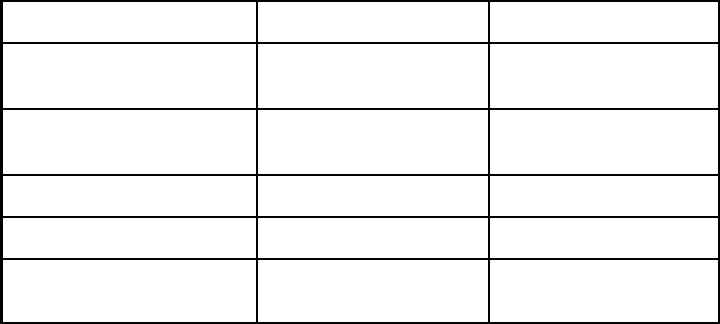
TLA 852/FLA 872
TM1205 Issue 2 Page 6 - 7
6.4.4 Banded Component: IC3
TLA 852 FLA 872
STANDARD (LATIN) 0501-0224 0501-0211 (OTP)
3835-0017 (MASKED)
STANDARD (CYRILLIC) 3835-0012 0501-0212 (OTP)
3835-0018 (MASKED)
"ZAP!" (MASKED) 3835-0020
Z-PAGE 0501-0228
MOROCCO 0501-0198 (OTP)
3835-0010 (MASKED)
ITEM/CIRCUIT
REFERENCE DESCRIPTION PART No.
6.4.5 Miscellaneous
BAT2 CAPACITOR, POLYESTER, PAS621L-VL5 3331-0002
LP1,2 LAMP HE1-5VXXMA 5202-0007
SK1 HEADER DUAL ROW RECEPT14WAYSMD 4449-0002
SW1,2,3 SWITCH SMD KSR221G 4202-0026
T1 TOROID SERIES 5CT 5301-0001
L25 INDUCTOR 680FH 20% 4124-0018
XL1 CRYSTAL 4.194304MHz SMD 3915-0019
DIFFUSER, DISPLAY 2361-5008
DISPLAY LCD EMC-A0861-1(EPSON) 5206-0019
LABEL DISPLAY BLANK TLA850 2061-5108
MOULDING, LCD BEZEL (EPSON) 0861-4878
EL1 ELECTRO-LUMINESCENT PANEL 5261-6071
MOTOR VIBRATE (WITH BRACKET) 6502-0007
TLA 852/FLA 872
TM1205 Issue 2Page 6 - 8
INTENTIONALLY BLANK
TLA 852/FLA 872
TM1205 Issue 2 Page 7 - 1
SECTION 7
DIAGRAMS
CONTENTS Source Drawing Page
7.1 Radio Board (PCB 3061-5374 Iss. 1) 2961-5375 Iss. 5 7-3/4
Circuit Diagram (Sheet 1 of 2) (Sheet 2)
7.2 Radio Board (PCB 3061-5374 Iss. 1) 2961-5375 Iss. 5 7-5/6
Circuit Diagram (Sheet 2 of 2) (Sheet 1)
7.3 Radio Board (PCB 3061-5374 Iss. 1) 0261-5373 Iss. 2 7-7/8
Component Layout - Side 1 (Sheet 1)
7.4 Radio Board (PCB 3061-5374 Iss. 1) 0261-5373 Iss. 2 7-9/10
Component Layout - Side 2 (Sheet 2)
7.5 Decoder Board (PCB 3061-5169 Iss. 1) 2961-5167 Iss. 2 7-11/12
Circuit Diagram
7.6 Decoder Board (PCB 3061-5169 Iss. 1) 0261-5168 Iss. 1 7-13/14
Component Layout
7.7 Decoder Board (PCB 3061-5169 Iss. 1) 0261-5168 Iss. 1 7-15/16
Component Layout
7.8 Decoder Board With EL Display (FLA) 2961-5878 Iss. 1 7-17/18
Circuit Diagram (PCB 3061-5880 Iss. 1)
7.9 Decoder Board With EL Display (FLA) 0261-5879 Iss. 1 7-19/20
Component Layout Side 1 Shts. 1 & 3
(PCB 3061-5880 Iss. 1)
7.10 Decoder Board With EL Display (FLA) 0261-5879 Iss. 1 7-21/22
Component Layout Side 2 Sht. 2
(PCB 3061-5880 Iss. 1)
TLA 852/FLA 872
TM 1205 Issue 2Page 7 - 2
INTENTIONALLY BLANK
